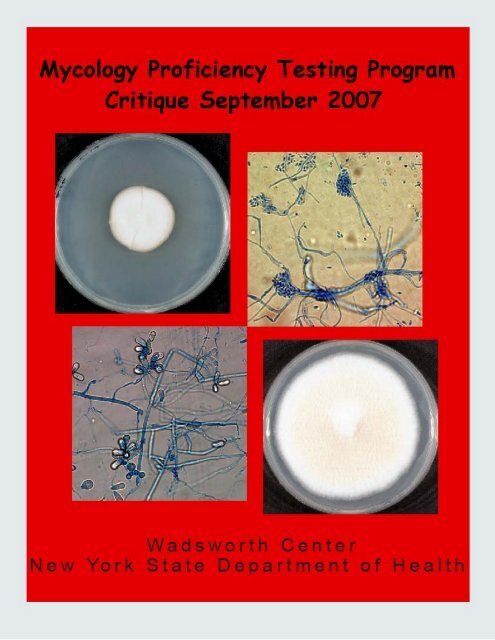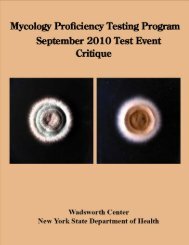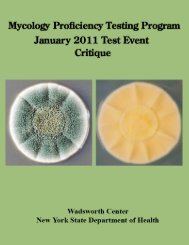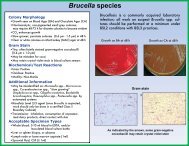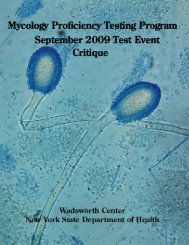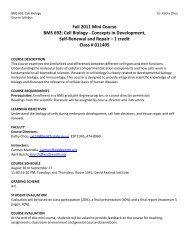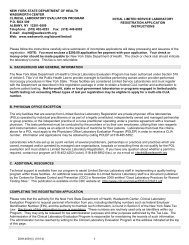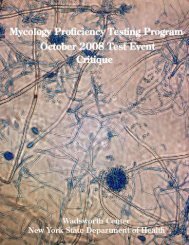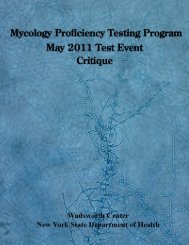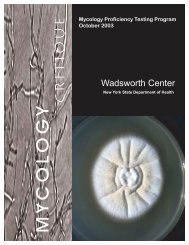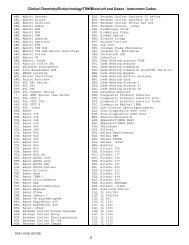September 2007 - Wadsworth Center
September 2007 - Wadsworth Center
September 2007 - Wadsworth Center
Create successful ePaper yourself
Turn your PDF publications into a flip-book with our unique Google optimized e-Paper software.
CONTENTSContents 3Schedules 4Test Specimens and Grading Policy 5Answer Keys 7Laboratory Performance Summary 8Test Statistics 9Mold Descriptions 10Malbranchea sp.Acremonium sp.Chrysosporium sp.Fusarium sp.Penicillium sp.Trichothecium sp.Yeast Descriptions 32Candida dubliniensisRhodotorula minutaCandida viswanathiiCandida parapsilosisTrichosporon asahiiAntifungal Susceptibility Testing for Yeasts 50Direct Detection - Cryptococcus neoformans Antigen Test 52Bibliography 55Page3
Schedule of <strong>2007</strong> Mycology PT Mailouts* , ‡GENERALGENERAL POSTMARK DEADLINESJanuary 31, <strong>2007</strong> March 16, <strong>2007</strong>May 23, <strong>2007</strong> June 15, <strong>2007</strong><strong>September</strong> 26, <strong>2007</strong> November 9, <strong>2007</strong>YEASTS ONLYYEASTS ONLY POSTMARK DEADLINESJanuary 31, <strong>2007</strong> February 23, <strong>2007</strong>May 23, <strong>2007</strong> June 15, <strong>2007</strong><strong>September</strong> 26, <strong>2007</strong> October 19, <strong>2007</strong>DIRECT DETECTION TESTINGDIRECT DETECTION TESTING POSTMARKDEADLINESJanuary 31, <strong>2007</strong> February 16, <strong>2007</strong><strong>September</strong> 26, <strong>2007</strong> October 12, <strong>2007</strong>ANTIFUNGAL SUSCEPTIBILITY FORYEASTSANTIFUNGAL SUSCEPTIBILITY FORYEASTS POSTMARK DEALINESJanuary 31, <strong>2007</strong> March 16, <strong>2007</strong>May 23, <strong>2007</strong> June 15, <strong>2007</strong><strong>September</strong> 26, <strong>2007</strong> November 9, <strong>2007</strong>*Please provide us with your email information so we could inform you when a new critique is postedonline.‡ Mycology PT Program has a set of standard test strains, which typically represent characteristic features ofthe respective species. These strains will be made available to the participating laboratories for educationalpurposes. For practical reasons, no more than two strains will be shipped at any given time subject to amaximum of five strains per year. Preference will be given to laboratories that request test strains forremedial purposes following unsatisfactory performance.4
A failure to attain an overall score of 80% is considered unsatisfactory performance. Laboratoriesreceiving unsatisfactory scores two out of three consecutive proficiency test events may be subject to ‘ceasetesting’ of clinical specimens.*The use of brand and/or trade names in this report does not constitute an endorsement of the products on thepart of the <strong>Wadsworth</strong> <strong>Center</strong> or the New York State Department of Health.6
ANSWER KEYMycology – GeneralSpecimen Key Validated Specimen Other Acceptable AnswersM-1 Malbranchea sp. Not validatedM-2 Acremonium sp. Acremonium sp.M-3 Chrysosporium sp. Chrysosporium sp.M-4 Fusarium sp. Fusarium sp. Fusarium oxysporumFusarium solaniM-5 Penicillium sp. Penicillium sp.M-Edu. Trichothecium sp. Trichothecium roseumMycology – Yeast OnlySpecimen Key Validated Specimen Other Acceptable AnswersY-1 Candida dubliniensis Candida dubliniensisY-2 Rhodotorula minuta Rhodotorula minutaY-3 Candida viswanathii Not validatedY-4 Candida parapsilosis Candida parapsilosisY-5 Trichosporon asahii Trichosporon asahiiMycology – Antifungal Susceptibility Testing for Yeasts (S-1: Candida albicans)DrugsValidated range (μg/ml)5-fluorocytosine 0.125 – 2.0Amphotericin B 0.06 – 2.0Caspofungin 0.015 – 1.0Fluconazole 0.06 – 4.0Itraconazole ≤ 0.015 – 0.5Ketoconzole ≤ 0.25Posaconazole ≤ 0.125Voriconazole ≤ 0.125Mycology – Direct detection (Cryptococcus Antigen Test)Specimen Key Validated Specimen Other Acceptable Titer RangeCn-Ag-1 Negative NegativeCn-Ag-2 Positive (1:16) Positive (1:16) 1:4 – 1:64Cn-Ag-3 Negative NegativeCn-Ag-4 Positive (1:128) Positive (1:128) 1:32 – 1:512Cn-Ag-5 Negative NegativeCn-Ag-Edu Positive (1:128) 1:32 – 1:5127
LABORATORY PERFORMANCE SUMMARYMycology – GeneralCorrect Responses/Total # Laboratories (%) Referees (%)M - 1 Malbranchea sp. 54/77 (70) 7/10 (70)M - 2 Acremonium sp. 75/77 (97) 10/10 (100)M - 3 Chrysosporium sp. 71/77 (92) 10/10 (100)M - 4 Fusarium sp. 76/77 (99) 10/10 (100)M - 5 Penicillium sp. 70/77 (91) 9/10 (90)Mycology – Yeast OnlyCorrect Responses/Total # Laboratories (%) Referees (%)Y - 1 Candida dubliniensis 41/52 (79) 9/10 (90)Y - 2 Rhodotorula minuta 51/52 (98) 10/10 (100)Y - 3 Candida viswanathii 1/51 (2) 0/10 (0)Y - 4 Candida parapsilosis 52/52 (100) 10/10 (100)Y - 5 Trichosporon asahii 49/52 (94) 9/10 (90)Mycology – Antifungal Susceptibility Testing for Yeasts (S- 1: Candida albicans)Correct Responses/Total # Laboratories (%)5-fluorocytosine 22/22 (100) Fluconazole 28/29 (97) Posaconazole 11/12 (92)Amphotericin B 23/23 (100) Itraconazole 23/25 (92) Voriconazole 20/20 (100)Caspofungin 19/19 (100) Ketoconzole 17/18 (94)Mycology – Direct detection (Cryptococcus Antigen Test)Correct Responses/Total # Laboratories (%)QualitativeQuantitativeCn-Ag-1 Negative 75/75 (100) NACn-Ag-2 Positive (1:16) 75/75 (100) 66/69 (96)Cn-Ag-3 Negative 74/75 (99) NACn-Ag-4 Positive (1:128) 75/75 (100) 67/69 (97)Cn-Ag-5 Negative 75/75 (100) NA8
TEST STATISTICSGeneralYeastOnlyAntifungalSusceptibilityTesting for YeastsDirectDetectionNumber of participating laboratories 78 53 29 76Number of referee laboratories 10 10 29 76Number of laboratories responding by deadline 77 52 29 75Number of laboratories responding after deadline 0 0 0 0Number of laboratories not responding 1 1 0 1Number of laboratories successfully completing this test 75 50 27 75Number of laboratories unsuccessfully completing this test 3 3 2 1Number of Laboratories Using Commercial Yeast Identification System*API 20C AUX 39AMS Vitek system 25Remel Uni-Yeast-Tek 4IDS Rapid System 3Microscan 1Number of Laboratories Using Commercial Antifungal Susceptibility Testing System/MethodYeastOne Colorimetric microdilution method 18Etest 5Disk diffusion method 1Others † 6Number of Laboratories Using Commercial Cryptococcus neoformansAntigen Detection SystemEIA method 2Meridien Diagnostic 2Latex Agglutination method 73Immuno-Mycologics 4Meridien Diagnostic 44Remel 5Wampole 22(*Include multiple systems used by some laboratories)( † Include laboratories using NCCLS Microbroth dilution method)9
MOLD DESCRIPTIONSM-1 Malbranchea sp.Source: LungScoring:No. LaboratoriesReferee Laboratories with correct ID: 7Laboratories with correct ID: 54Laboratories with incorrect ID: 23(Arthrographis sp.) (21)(Emmonsia parva) (1)(Trichophyton terrestre) (1)Clinical Significance: Malbranchea sp. is not a known human pathogenic fungus. It has been isolated froma variety of clinical specimens – skin lesions, toe nails, CSF, sinus, etc.Ecology: Malbranchea sp. is found worldwide in soil, decaying vegetation and animal dung.Laboratory Diagnosis:1. Culture – Colonies on Sabouraud dextrose agar and potato dextrose agar were wooly to powdery intexture, grew rapidly, and color ranged from white, pink, buff to brown (Figure 1A). The reverse waswhite, yellow, to buff towards the center (Figure 1B). Like other saprobes, Malbranchea sp. wascycloheximide- sensitive.2. Microscopic morphology – Lactophenol Cotton Blue or Calcofluor mount revealed hyaline, septatehyphae with no conidiophores. Fragmentation of hyphae caused formation of arthroconidia, which hadthe same diameter as that of the hyaline hyphae and alternate with disjunctor cells (Figure 2).3. Differentiation from other molds – Malbranchea sp. produces alternate arthroconidia, which have thesame width as that of the vegetative hyphae. Once this arthroconidia are liberated along with the ‘annularfrills’ (the remnants of disjunctor cells), the fungus closely resembles Coccidioides immitis.Arthrographis sp. can also be confused with Malbranchea species. However Arthrographis sp. producesarthroconidia from conidiophores. There may be some resemblance to Odiodendron sp., which is adematiaceous, arthroconidia-forming fungi. These features are summarized in Table 1.4. In vitro susceptibility testing – The limited susceptibility testing data available showed that this organismwas susceptible to amphotericin B, and azoles like itraconazole, ketoconazole but resistant tofluconazole.5. Molecular tests – Very limited information available. Internal transcribed spacer (ITS) regions can beused for Malbranchea sp. identification.The identity of the test isolate was confirmed in Mycology PTP program by sequencing of its ITS1 andITS2 regions of rDNA. 100% identity was found between this PT specimen and Malbranchea filamentosaUAMH9987 (Genebank accession number: AY177301) for both ITS1 and ITS2 regions.Comments: This specimen was not validated in this test event although it was sent by our programpreviously (Oct. 2000 Test Event). The isolate sent in the present testing event resembled C. immitis.However, the isolate did not grow in the presence of cycloheximide, and also had a negative reaction for C.immitis DNA probe. Many labs reported this isolate as Arthrographis species, which could be easily10
differentiated by presence of conidiophore. It is important to distinguish between Malbranchea species andC. immitis as the later is a highly virulent and increasingly being reported outside of its endemic zone in theSouthwest. Trichophyton terrestre produces 2-6 cells long, cylindrical macroconidia, which are verydifferent from arthroconidia of Malbranchea sp. Emmonsia parva can grow in the presence of cycloheximidebut Malbranchea sp. does not.Sequences alignment:Query 1 CATTAAAGTGTTAAGCCGGCGCCTCCGTGTGCCGGTGAAACTCCACCCTTGACTACTATA 60||||||||||||||||||||||||||||||||||||||||||||||||||||||||||||AY177301 1 CATTAAAGTGTTAAGCCGGCGCCTCCGTGTGCCGGTGAAACTCCACCCTTGACTACTATA 60Query 61 CCACATGTTGCTTTGGCGGGCCCGCCTCCGGGCCGCCGGGGGCCCTGCCCCTGGCCCGCG 120||||||||||||||||||||||||||||||||||||||||||||||||||||||||||||AY177301 61 CCACATGTTGCTTTGGCGGGCCCGCCTCCGGGCCGCCGGGGGCCCTGCCCCTGGCCCGCG 120Query 121 CCCGCCAGAGATACACTGAACCCTTTGTGAAATTGGACGTCTGAGTTGATGATCAATCAT 180||||||||||||||||||||||||||||||||||||||||||||||||||||||||||||AY177301 121 CCCGCCAGAGATACACTGAACCCTTTGTGAAATTGGACGTCTGAGTTGATGATCAATCAT 180Query 181 TAAAACTTTCAACAATGGATCTCTTGGTTCCGGCATCGATGAAGAACGCAGC 232||||||||||||||||||||||||||||||||||||||||||||||||||||AY177301 181 TAAAACTTTCAACAATGGATCTCTTGGTTCCGGCATCGATGAAGAACGCAGC 232Alignment of primary sequence of the ITS1 regions of Auxarthron filamentosum (anamorph: Malbranchea filamentosa) UAMH9987 and PT specimen Malbranchea sp. NYSDOH 0907.Query 1 CATCGATGAAGAACGCAGCGAAATGCGATAAGTAATGTGAATTGCAGAATTCCGTGAATC 60||||||||||||||||||||||||||||||||||||||||||||||||||||||||||||AY177301 214 CATCGATGAAGAACGCAGCGAAATGCGATAAGTAATGTGAATTGCAGAATTCCGTGAATC 273Query 61 ATCGAATCTTTGAACGCACATTGCGCCCCCTGGTATTCCGGGGGGCATGCCTGTCCGAGC 120||||||||||||||||||||||||||||||||||||||||||||||||||||||||||||AY177301 274 ATCGAATCTTTGAACGCACATTGCGCCCCCTGGTATTCCGGGGGGCATGCCTGTCCGAGC 333Query 121 GTCATTGCAACCCTCAAGCGCGGCTTGTGTGTTGGGCCTCGTCCCCCGTGGACGTGCCCG 180||||||||||||||||||||||||||||||||||||||||||||||||||||||||||||AY177301 334 GTCATTGCAACCCTCAAGCGCGGCTTGTGTGTTGGGCCTCGTCCCCCGTGGACGTGCCCG 393Query 181 AAAGGCAGTGGCGGCGTCCGTTTCGGTGCCCGAGCGTATGGGAACTCTTATACCGCTCGA 240||||||||||||||||||||||||||||||||||||||||||||||||||||||||||||AY177301 394 AAAGGCAGTGGCGGCGTCCGTTTCGGTGCCCGAGCGTATGGGAACTCTTATACCGCTCGA 453Query 241 AGGGCCCGGCGGCGCTGGTCAGAACCAAATCTTTTACCGGTTGACCTCGGATCAGG 296||||||||||||||||||||||||||||||||||||||||||||||||||||||||AY177301 454 AGGGCCCGGCGGCGCTGGTCAGAACCAAATCTTTTACCGGTTGACCTCGGATCAGG 509Alignment of primary sequence of the ITS2 regions of Auxarthron filamentosum (anamorph: Malbranchea filamentosa) UAMH9987 and PT specimen Malbranchea sp. NYSDOH 0907.Further Reading:1. Brenda, T.J. Jr. and Corey, J.P. 1994. Malbranchea pulchella fungal sinusitis. Otolaryngology – Headand Neck Surgery. 110: 501 – 504.2. Currah, R.S. 1985. Taxonomy of the Onygenales: Arthrodermataceae, Gymnoascaceae, Myxotrichaceae,and Onygenaceae. Mycotaxon. 24: 1 –216.11
3. Kaufman, L., Standard, P.G., Huppert, M., and Pappagianis, D. 1985. Comparison and diagnostic valueof the coccidioidin heat-stable (HS and tube precipitin) antigens in immunodiffusion. J ClinMicrobiology.4. 22: 515 – 518.5. Padhye, A.A., Smith, G., Standard, P.G., McLaughlin, D., and Kaufman, L. 1994. Comparativeevaluation of chemiluminescent DNA probe assays and exotigen tests for rapid identification ofBlastomyces dermatitidis and Coccidioides immitis. J Clin Microbiology. 32: 867 – 870.6. Pan, S., Sigler, L., and Cole, G.T. 1994. Evidence for a phylogenetic connection between Coccidioidesimmitis and Uncinocarpus reesii (Onygenaceae). Microbiology. 140: 1481 – 1494.7. Pounder, J.I., Hansen, D., and Woods, G.L. 2006. Identification of Histoplasma capsulatum, Blastomycesdermatitidis, and Coccidioides species by repetitive-sequence-based PCR. J Clin Microbiol. 44: 2977-2982.12
TABLE 1: Summary of features that differentiate some arthroconidia- producing fungi.Characteristic Malbranchea sp. Coccidioides Arthrographis sp. Odiodendron sp.immitis/posadasiiGrowth oncycloheximidemedium (25°C)No growth Growth No growth No growthConidiophores None Present Present Dark-coloredGrowth andmorphology(37°C)No or poor growthThick walledspherules filledwith endospores*Very little growthVery little growthC.immitisGenProbeNegative Positive Negative Negative*In vitro conversion to tissue form may not be easily obtained, may require prolonged incubationunder 5% CO 2 .13
A. B.Figure 1. (A) One-week-old colony of Malbranchea sp. on Sabouraud’s dextrose agar showing woolytexture. (B) The reverse of seven-day-old Malbranchea sp. colony on Sabouraud’s dextrose agarA. B.Figure 2. Microscopic morphology of Malbranchea species showing arthroconidia, which are similar in sizeto vegetative hyphae (A: 400× magnification; B: line drawing on right not to scale.)14
M-2 Acremonium sp.Source: ToeScoring:No. LaboratoriesReferee Laboratories with correct ID: 10Laboratories with correct ID: 75Laboratories with incorrect ID: 2(Aureobasidium pullulans) (1)(Trichophyton terrestre) (1)Clinical Significance: Acremonium sp. causes onychomycosis, keratitis, endophthalmitis, endocarditis,meningitis, peritonitis, and osteomyelitis, especially in immunocompromised patients.Ecology: Acremonium sp. is cosmopolitan in distribution, commonly isolated from plant debris and soil.Laboratory Diagnosis:1. Culture – Acremonium sp. grew moderately rapidly. The colony was powdery to velvety, white to palepink (Figure 3A). The reverse was pale to yellowish (Figure 3B).2. Microscopic morphology – Lactophenol cotton blue mount showed hyaline, fine and narrow septatehyphae, often in form of fascicle. Phialides were unbranched, solitary. Unicellular conidia accumulatedin heads at the apices of the phialides, oblong to ovoid (Figure 4).3. Differentiation from other molds – Acremonium species can be confused with certain non-macroconidiaproducing species of Fusarium and Verticillium strains, which produce solitary phialides. Both Fusariumand Verticillium spp. grow faster than Acremonium and produce deeply woolly colonies. Acremoniumspecies can be distinguished from Lecythophora and Phialemonium spp. by the presence of septabetween the base of phialides and hyphae. Gliomastix sp. is different from Acrmonium sp. by havingolive-green to greenish-black colonies and chains or balls of dark conidia.4. In vitro susceptibility testing – In general, Acremonium sp. is susceptible to amphotericin B, caspofungin,voriconazole, posaconazole, and itraconazole.5. Molecular tests – Internal transcribed spacer (ITS) regions can be used for Acremonium spp.identification.The identity of the test isolate was confirmed in Mycology PTP program by sequencing of its ITS1 andITS2 regions of rDNA. 100% identity was found between this PT specimen and Acremonium strictum UW580 (Genebank accession number: AY138848) for both ITS1 and ITS2 regions.Comments: One participating laboratory reported this specimen as Aureobasidium pullulans, which hasmucoid texture, becoming black with age; another laboratory reported it as Trichophyton terrestre, whichforms cylindrical macroconidia.Sequences alignment:Query 1 TCCGTAGGTGAACCTGCGGAGGGATCATTACCAGAGTGCCCTAGGCTCTCCAACCCATTG 60||||||||||||||||||||||||||||||||||||||||||||||||||||||||||||AY138848 1 TCCGTAGGTGAACCTGCGGAGGGATCATTACCAGAGTGCCCTAGGCTCTCCAACCCATTG 60Query 61 TGAACTTACCAAACGTTCCCTCGGCGGGCTCAGCGCGCGGTGGCCTCCGGGCCTCCGGGC 120||||||||||||||||||||||||||||||||||||||||||||||||||||||||||||AY138848 61 TGAACTTACCAAACGTTCCCTCGGCGGGCTCAGCGCGCGGTGGCCTCCGGGCCTCCGGGC 12015
Query 121 GTCCGCCGGGGAAAACCAAACCCTGATTTAATCGTATTTCTCTGAGGGGCGAAAGCCCGA 180||||||||||||||||||||||||||||||||||||||||||||||||||||||||||||AY138848 121 GTCCGCCGGGGAAAACCAAACCCTGATTTAATCGTATTTCTCTGAGGGGCGAAAGCCCGA 180Query 181 AAACAAAATGAATCAAAACTTTCAACAACGGATCTCTTGGCTCTGGCATCGATGAAGAAC 240||||||||||||||||||||||||||||||||||||||||||||||||||||||||||||AY138848 181 AAACAAAATGAATCAAAACTTTCAACAACGGATCTCTTGGCTCTGGCATCGATGAAGAAC 240Query 241 GCAGC 245|||||AY138848 241 GCAGC 245Alignment of primary sequence of the ITS1 regions of Acremonium strictum UW 580 and PT specimen Acremonium sp.NYSDOH 0907.Query 1 CATCGATGAAGAACGCAGCGAAATGCGATAAGTAATGTGAATTGCAGAATTCAGTGAATC 60||||||||||||||||||||||||||||||||||||||||||||||||||||||||||||AY138848 227 CATCGATGAAGAACGCAGCGAAATGCGATAAGTAATGTGAATTGCAGAATTCAGTGAATC 286Query 61 ATCGAATCTTTGAACGCACATTGCGCCCGCCGGCACTCCGGCGGGCATGCCTGTCCGAGC 120||||||||||||||||||||||||||||||||||||||||||||||||||||||||||||AY138848 287 ATCGAATCTTTGAACGCACATTGCGCCCGCCGGCACTCCGGCGGGCATGCCTGTCCGAGC 346Query 121 GTCATTTCAACCCTCAGGCCCACCCTTCCGGGGGAGCGGGCCTGGTGCTGGGGATCGGCG 180||||||||||||||||||||||||||||||||||||||||||||||||||||||||||||AY138848 347 GTCATTTCAACCCTCAGGCCCACCCTTCCGGGGGAGCGGGCCTGGTGCTGGGGATCGGCG 406Query 181 GCCCTCGCGGCCCCCGTCCCTCAAATACAGTGGCGGTCGCGCCGCAGCCTCCCCTGCGTA 240||||||||||||||||||||||||||||||||||||||||||||||||||||||||||||AY138848 407 GCCCTCGCGGCCCCCGTCCCTCAAATACAGTGGCGGTCGCGCCGCAGCCTCCCCTGCGTA 466Query 241 GTAGCACAACCTCGCACCGGAGAGCGGAACGACCACGCCGTGAAACCCCCAATTTTTTAA 300||||||||||||||||||||||||||||||||||||||||||||||||||||||||||||AY138848 467 GTAGCACAACCTCGCACCGGAGAGCGGAACGACCACGCCGTGAAACCCCCAATTTTTTAA 526Query 301 GGTTGACCTCGGATCAGGTAGGAATACCCGCTGAACTTAAGCATATCAATAAGCGGAGGA 360||||||||||||||||||||||||||||||||||||||||||||||||||||||||||||AY138848 527 GGTTGACCTCGGATCAGGTAGGAATACCCGCTGAACTTAAGCATATCAATAAGCGGAGGA 586Alignment of primary sequence of the ITS2 regions of Acremonium strictum UW 580 and PT specimen Acremonium sp.NYSDOH 0907.Further Reading:1. Chang, Y.H., Huang, L.M., Hsueh, P.R., Hsiao, C.H., Peng, S.F., Yang, R.S., and Lin, K.H. 2005.Acremonium pyomyositis in a pediatric patient with acute leukemia. Pediatr Blood Cancer. 44: 521-524.2. Creti, A., Esposito, V., Bocchetti, M., Baldi, G., De Rosa, P., Parrella, R., and Chirianni, A. 2006.Voriconazole curative treatment for Acremonium species keratitis developed in a patient withconcomitant Staphylococcus aureus corneal infection: a case report. In Vivo. 20: 169-171.3. Doczi, I., Dosa, E., Varga, J., Antal, Z., Kredics, L., and Nagy, E. 2004. Etest for assessing thesusceptibility of filamentous fungi. Acta Microbiol Immunol Hung. 51: 271-81.4. Foell, J.L., Fischer, M., Seibold, M., Borneff-Lipp, M., Wawer, A., Horneff, G., and Burdach, S. <strong>2007</strong>.Lethal double infection with Acremonium strictum and Aspergillus fumigatus during inductionchemotherapy in a child with ALL. Pediatr Blood Cancer. 49: 858-861.16
5. Garcia-Effron, G., Gomez-Lopez, A., Mellado, E., Monzon, A., Rodriguez-Tudela, J.L., and Cuenca-Estrella, M. 2004. In vitro activity of terbinafine against medically important non-dermatophyte speciesof filamentous fungi. J Antimicrob Chemother. 53: 1086-1089.6. Pastorino, A.C., Menezes, U.P., Marques, H.H., Vallada, M.G., Cappellozi, V.L., Carnide, E.M., andJacob, C.M. 2005. Acremonium kiliense infection in a child with chronic granulomatous disease. Braz JInfect Dis. 9: 529-534.17
A. B.Figure 3. (A) Seven-day-old, powdery to velvet, white to pinkish colony of Acremonium sp. on Sabouraud’sdextrose agar. (B) The reverse of seven-day-old Acremonium sp. colony on Sabouraud’s dextrose agarFigure 4. Microscopic morphology of Acremonium sp. showing septate, rope-like hyphae, unbranchedphialides, and unicellular conidia accumulated in heads at the apices of the phialides (400× magnification).18
M-3 Chrysosporium sp.Source: Bronchial washScoring:No. LaboratoriesReferee Laboratories with correct ID: 10Laboratories with correct ID: 71Laboratories with incorrect ID: 6(Malbranchea sp.) (3)(Arthrographis sp.) (1)(Emmonsia parva) (1)(Scedosporium apiospermum) (1)Clinical Significance: Chrysosporium sp. is occasionally reported from skin infection, or as an agent ofonychomycosis. Invasive Chrysosporium infection of the nose and paranasal sinuses in animmunocompromised host has also been reported.Ecology: Chrysosporium sp. is a common saprobe on plants and in soil distributed worldwide.Laboratory Diagnosis:1. Culture – Chrysosporium sp. grew moderately fast. On Sabouraud’s dextrose agar, after 9 days at 25°C,the colony showed white to cream color on the surface and powdery to granular texture (Figure 5A).Reverse appeared yellow or buff (Figure 5B). The species of Chrysosporium sent in this testing wascycloheximide-resistant.2. Microscopic morphology – Lactophenol cotton blue mount showed hyaline septate hyphae. Ovoid orclub-shaped conidia with broad truncated bases were seen either singly or in short chains borne directlyon hyphae, or in short conidiophores (Figure 6).3. Differentiation from other mold – Chrysosporium sp. is distinct from Emmonsia sp. in not developingadiaspores at 37°C. It does not display thermal dimorphism and is negative with specific nucleic acidprobe, which serves to differentiate it from Blastomyces dermatititidis. Chrysosporium sp. grows on themedia with cycloheximide and is urease-positive, which distinguished it from Sporotrichum sp. Pleaserefer to Table 2 for details.4. In vitro susceptibility testing – Limited information is available. In general, Chrysosporium sp. issusceptible to amphotericin B, itraconazole, ketoconazole, and voriconazole. Fluconazole had higherMIC to Chrysosporium sp.5. Molecular tests – Internal transcribed spacer (ITS) regions can be used for Chrysosporium sp.identification.The identity of the test isolate was confirmed in the Mycology PTP program by sequencing of its ITS1and ITS2 regions of rDNA. 96% and 97% identities were found between this PT specimen andChrysosporium articulatum UAMH 4320 (Genebank accession number: AJ007841) for ITS1 and ITS2regions, respectively.Comments: Conidia of Chrysosporium sp. are pyriform with truncated bases, which are similar to those ofScedosporium apiospermum. However, S. apiospermum has large, dark, rounded cleistothecia with thickwalls, while Chrysosporium sp. does not. Arthrographis sp. produces arthroconidia formed at the tips ofconidiophores or intercalary in the hyphae, which are different from the arthroconidia of Chrysosporium sp.,most often broader in diameter than the supporting hyphae. Arthroconidia of Malbranchea sp. are also19
ectangular, of the same diameter as the hyphae from which they are formed, which is different fromarthroconidia of Chrysosporium sp. Emmonsia parva develops adiaspores at 37°C, but Chrysosporium sp.does not.Sequences alignment:Query 1 TTCCGTAGGNG-NCCTGCGGAAGGATCATTAAAGTGTTTCGGAGCCTGGT-TCGGGCACC 58||||||||| | ||||||||||||||||||||||||||||||||||||| | ||||| |AJ007841 24 TTCCGTAGGTGAACCTGCGGAAGGATCATTAAAGTGTTTCGGAGCCTGGTAT-GGGCATC 82Query 59 TCAGCTCGAGGTGTCGGTGCCAGCGCCCCCACACGTGTTTACTCAACTTGGTTGCCTTGG 118||| ||||||||||||||||||||||||||||||||||||||||||||||||||||||||AJ007841 83 TCAACTCGAGGTGTCGGTGCCAGCGCCCCCACACGTGTTTACTCAACTTGGTTGCCTTGG 142Query 119 CGAGCCTGCCCCTGTGGCTGCTGGGGACGCCTCACGGTGTCCCGGGCTTGTGCTCGCCAG 178|||||||||| ||||||||||||||| |||||||||||||||||||| |||||||||||AJ007841 143 TGAGCCTGCCCTTGTGGCTGCTGGGGATGCCTCACGGTGTCCCGGGCTCGTGCTCGCCAG 202Query 179 TGGAACATTTGAACTCTTATGTGAAAATAGTCAGTCTGAGCATTATGCAAATTAAATAAA 238||||||||||||||||||||||||||||||||||||||||||||||||||||||||||||AJ007841 203 TGGAACATTTGAACTCTTATGTGAAAATAGTCAGTCTGAGCATTATGCAAATTAAATAAA 262Query 239 ACTTTCAACAACGGATCTCTTGGTTCCGGCATCGATGAAGAACGCAG 285|||||||||||||||||||||||||||||||||||||||||||||||AJ007841 263 ACTTTCAACAACGGATCTCTTGGTTCCGGCATCGATGAAGAACGCAG 309Alignment of primary sequence of the ITS1 regions of Chrysosporium articulatum UAMH 4320 and PT specimen Chrysosporiumsp. NYSDOH 0907.Query 1 GCATCGAT-NAGAACGCAGCGAAATGCGATAAGTAATGTGAATTGCAGAATTCCGTGAAT 59|||||||| ||||||||||||||||||||||||||||||||||||||||||||||||||AJ007841 291 GCATCGATGAAGAACGCAGCGAAATGCGATAAGTAATGTGAATTGCAGAATTCCGTGAAT 350Query 60 CATCGAATCTTTGAACGCACATTGCGCCCTCTGGTATTCCGGGGGGCATGCCTGTTCGAG 119||||||||||||||||||||||||||||||||||||||||||||||||||||||||||||AJ007841 351 CATCGAATCTTTGAACGCACATTGCGCCCTCTGGTATTCCGGGGGGCATGCCTGTTCGAG 410Query 120 CGTCATTGCAACCCCTCAAGCACGGCTTGTGTGTTGGGTCATCGTCCCTCTTTGTGGACG 179||||||||||||||||||||||| |||||||||||||| ||||||||||| ||||||AJ007841 411 CGTCATTGCAACCCCTCAAGCACAGCTTGTGTGTTGGGCCATCGTCCCTC----TGGACG 466Query 180 GGCCTGAAATGCAGTGGCAGCACCGAGTTCTGGTGTCTGAGTGTATGGGAATCTCTTATC 239||||||||||||||||||||||||||||||||||||||||||||||||||||||||||||AJ007841 467 GGCCTGAAATGCAGTGGCAGCACCGAGTTCTGGTGTCTGAGTGTATGGGAATCTCTTATC 526Query 240 GCTCAAAGACCCAATCGGCGCTGATGTCAGATTTTTATCCAGTTTGACCTCGGATCAGGT 299||||||||||||||||||||||||||||||||||||||||||||||||||||||||||||AJ007841 527 GCTCAAAGACCCAATCGGCGCTGATGTCAGATTTTTATCCAGTTTGACCTCGGATCAGGT 586Query 300 AGGAGTACCCGCTGAACTTAAGCATATCAATAAGCGGA 337||||||||||||||||||||||||||||||||||||||AJ007841 587 AGGAGTACCCGCTGAACTTAAGCATATCAATAAGCGGA 624Alignment of primary sequence of the ITS2 regions of Chrysosporium articulatum UAMH 4320 and PT specimen Chrysosporiumsp. NYSDOH 0907.20
Further Reading:1. Bowman, M.R., Pare, J.A., Sigler, L., Naeser, J.P., Sladky, K.K., Hanley, C.S., Helmer, P., Phillips,L.A., Brower, A., and Porter, R. <strong>2007</strong>. Deep fungal dermatitis in three inland bearded dragons (Pogonavitticeps) caused by the Chrysosporium anamorph of Nannizziopsis vriesii. Med Mycol. 45: 371-376.2. Guerrero Palma, M.A., Avila Espin, L., Fernandez Perez, A., Moreno Leon, J.A. <strong>2007</strong>. Invasive sinusalmycosis due to Chrysosporium tropicum. Acta Otorrinolaringol Esp. 58: 164-166.3. Levy, F.E., Larson, J.T., George, E., and Maisel, R.H. 1991. Invasive Chrysosporium infection of thenose and paranasal sinuses in an immunocompromised host. Otolaryngol. Head neck Surg. 104: 384-388.4. Roilides, E., Sigler, L., Bibashi, E., Katsifa, H., Flaris, N., and Panteliadis, C. 1999. Disseminatedinfection due to Chrysosporium zonatum in a patient with chronic granulomatous disease and review ofnon-Aspergillus fungal infections in patients with this disease. J Clin Microbiol. 37: 18-25.21
TABLE 2: Differentiation of Chrysosporium species from some related fungi.Characteristic Chrysosporium sp. Emmonsia parva var. parvaand var. crescensBlastomycesdermatitidisGrowth oncycloheximidemedium (25°C)No growth Growth GrowthChlamydoconidia(25°C)More than 20 μm indiameterAbsentAbsentChlamydoconidia /adiaspores (37°C)Globose, pyriform,> 20 μm in diameterGlobose, thick walledchlamyconidia (10 – 20 μm);adiaspores (40 – 200 μm)Yeast form withbroad-base budding(8 –30 μm)B. dermatitidisGenProbeNegative Negative Positive22
A. B.Figure 5. (A) Nine-day-old, white to cream colored powdery to granular colony of Chrysosporium sp. onSabouraud’s dextrose agar. (B) The reverse of nine-day-old Chrysosporium sp. colony on Sabouraud’sdextrose agarA. B.Figure 6. Microscopic morphology of Chrysosporium sp. showing hyaline septate hyphae. Ovoid or clubshapedconidia with broad truncated bases are seen either singly or in short chains borne directly on hyphaeor in short conidiophores (A: 200× magnification; B: line diagram not to scale).23
M-4 Fusarium sp.Source: NailsScoring:No. LaboratoriesReferee Laboratories with correct ID: 10Laboratories with correct ID: 76Laboratories with incorrect ID: 1(Acremonium sp.) (1)Clinical Significance: A frequent casual agent of keratitis, endophthalmitis, and onychomycosis in healthyindividuals. It has been reported from peritonitis and disseminated infection in immunocompromisedpatients.Ecology: Cosmopolitan in soil and plants. Some species of Fusarium are major plant pathogens.Laboratory Diagnosis:1. Culture – Fusarium grew fast on Sabouraud’s dextrose agar. After 5 days, colony was white, pinkish, topurplish in color, wooly with orange, to red–violet reverse (Figure 7).2. Microscopic morphology – Lactophenol cotton blue or Calcofluor mounts showed septate hyphae, withshort or long phialides. Microconidia were ovoid, and macroconidia were septate and curvedboat/banana-shaped(Figure 8). Chlamydospores may be present.3. Differentiation from other molds – Fusarium species produce curved, septate macroconidia along withsingle-cell microconidia, which distinguish them from other hyphomycetes, especially Acremoniumspecies.4. In vitro susceptibility testing – Most clinical isolates are susceptible to amphotericin B. Some isolates arevariably susceptible to azoles.5. Molecular tests – PCR method for rapid detection and identification of Fusarium species from cultureand clinical samples was described. Pan-fungal PCR, followed by nested PCR with species–specificprimers was reported for rapid detection of Fusarium DNA in ocular samples.Comments: One participating laboratory reported this specimen as Acremonium sp. possibly because theydid not observe macroconidia of Fusarium.Further Reading:1. Calado, N.B., Sousa, F. Jr, Gomes, N.O., Cardoso, F.R., Zaror, L.C., and Milan, E.P. 2006. Fusariumnail and skin infection: a report of eight cases from Natal, Brazil. Mycopathologia. 161: 27-31.2. Klont, R.R., Eggink, C.A., Rijs, A.J., Wesseling, P., and Verweij, P.E. 2005. Successful treatment ofFusarium keratitis with cornea transplantation and topical and systemic voriconazole. Clin Infect Dis. 40:e110-112.3. Hay, R.J. <strong>2007</strong>. Fusarium infections of the skin. Curr Opin Infect Dis. 20: 115-117.4. Ho, D.Y., Lee, J.D., Rosso, F., and Montoya, J.G. <strong>2007</strong>. Treating disseminated fusariosis: amphotericinB, voriconazole or both? Mycoses. 50: 227-231.5. Lin, H.C., Chu, P.H., Kuo, Y.H., and Shen, S.C. 2005. Clinical experience in managing Fusarium solanikeratitis. Int J Clin Pract. 59: 549-554.6. Qiu, W.Y., Yao, Y.F., Zhu, Y.F., Zhang, Y.M., Zhou, P., Jin, Y.Q., and Zhang, B. 2005. Fungal spectrumidentified by a new slide culture and in vitro drug susceptibility using Etest in fungal keratitis. Curr EyeRes. 30: 1113-1120.24
7. Sagnelli, C., Fumagalli, L., Prigitano, A., Baccari, P., Magnani, P., and Lazzarin, A. 2006. Successfulvoriconazole therapy of disseminated Fusarium verticillioides infection in an immunocompromisedpatient receiving chemotherapy. J Antimicrob Chemother. 57: 796-798.8. Thomas, P.A., and Geraldine, P. <strong>2007</strong>. Infectious keratitis. Curr Opin Infect Dis. 20: 129-141.9. Weinstein, W.L., Moore, P.A., Sanchez, S., Dietrich, U.M., Wooley, R.E., Ritchie, B.W. 2006. In vitroefficacy of a buffered chelating solution as an antimicrobial potentiator for antifungal drugs againstfungal pathogens obtained from horses with mycotic keratitis. Am J Vet Res. 67: 562-568.10. Woodward, L. 2005. Skin infection with Fusarium. Dermatol Nurs. 17: 455.25
A. B.Figure 7. (L) Seven-day-old, wooly, orange to pinkish colony of Fusarium sp. on Sabouraud’s dextroseagar. (R) The reverse side of seven-day-old Fusarium sp. colony on Sabouraud’s dextrose agar.A. B.Figure 8. Microscopic morphology of Fusarium sp. showing curved, septate microconidia and elongatedmicroconidia (A, 200× magnification; B: line drawing not to scale)26
M-5 Penicillium sp.Source: SinusScoring:No. LaboratoriesReferee Laboratories with correct ID: 9Laboratories with correct ID: 71Laboratories with incorrect ID: 7(Paecilomyces sp.) (6)(Scedosporium apiospermum) (1)Clinical Significance: Penicillium spp. other than Penicillium marneffei are commonly considered aslaboratory contaminants. Penicillium spp. have been isolated from patients with keratitis, endophtalmitis,otomycosis, necrotizing esophagitis, pneumonia, endocarditis, peritonitis, and urinary tract infections. Somespecies are known to produce mycotoxins, which are nephrotoxic and carcinogenic.Ecology: Penicillium spp. are widespread and are found in soil, decaying vegetables and fruits, and the air.Laboratory Diagnosis:1. Culture –Penicillium sp. grew rapidly, velvety to powdery in texture. The colony was initially white andthen became blue green, gray green, olive gray in time (Figure 9A). The plate reverse was pale toyellowish (Figure 9B).2. Microscopic morphology – Lactophenol cotton blue or Calcofluor mounts showed septate hyalinehyphae, simple or branched conidiophores, metulae, phialides. Metulae were secondary branches thatform on conidiophores. The brush-like clusters of phialides, are referred to as "penicilli". The unicellularconidia were round, and formed chains at the tips of the phialides (Figure 10).3. Differentiation from other mold – Penicillium sp. can be differentiated from Paecilomyces by havingflask-shaped phialides and globose to subglobose conidia; from Gliocladium by having chains of conidia;and from Scopulariopsis by forming phialides.4. In vitro susceptibility testing – In general, Penicillium sp. is susceptible to amphotericin B, ketoconazole,itraconazole, and voriconazole.5. Molecular tests – Internal transcribed spacer (ITS) regions can be used for Penicillium spp. identification.Comments: Five laboratories reported this specimen as Paecilomyces sp., which has thin phialides withelongated tips, but Penicillium sp. has phialides with thicker apices.Further Reading:1. Deshpande, S. D., and G. V. Koppikar. 1999. A study of mycotic keratitis in Mumbai. Indian J PatholMicrobiol. 42: 81-87.2. Keceli, S., Yegenaga, I., Dagdelen, N., Mutlu, B., Uckardes, H., and Willke, A. 2005. Case report:peritonitis by Penicillium spp. in a patient undergoing continuous ambulatory peritoneal dialysis. Int UrolNephrol.37: 129-131.3. Noritomi, D.T., Bub, G.L., Beer, I., da Silva, A.S., de Cleva, R., and Gama-Rodrigues, J.J. 2005.Multiple brain abscesses due to Penicillium spp infection. Rev Inst Med Trop Sao Paulo. 47: 167-170.4. Zanatta, R., Miniscalco, B., Guarro, J., Gené, J., Capucchio, M.T., Gallo, M.G., Mikulicich, B., Peano,A. 2006. A case of disseminated mycosis in a German Shepherd dog due to Penicillium purpurogenum.Med Mycol. 44: 93-97.27
A. B.Figure 9. (A) Seven-day-old, white edge, blue green, to olive green colony of Penicillium sp. onSabouraud’s dextrose agar. (B) The reverse of seven-day-old Penicillium sp. colony on Sabouraud’s dextroseagarFigure 10. Microscopic morphology of Penicillium sp. showing the broom-shape of phialides and roundconidia (200× magnification).28
M-Edu. Trichothecium sp.Source: SkinScoring:No. LaboratoriesReferee Laboratories with correct ID: 10Laboratories with correct ID: 76Laboratories with incorrect ID: 1(Trichophyton terrestre) (1)Clinical Significance: No human or animal diseases due to Trichothecium sp. have been reported. It iscommonly considered as a laboratory contaminant.Ecology: Trichothecium sp. is widely distributed on decaying vegetation and in the soil.Laboratory Diagnosis:1. Culture – Trichothecium sp. grew rapidly. On Sabouraud’s dextrose agar at 25°C for 7 days, the colonywas velvety to powdery, initially white and later becoming pale pink (Figure 11A). The reverse was pale(Figure 11B).2. Microscopic morphology – Lactophenol cotton blue mounts showed septate hyphae, hyaline, unbranchedconidiophore, and broadly club-shaped conidia. The conidia were two-celled, overlapping in animbricate, zigzagging at the tip of the conidiophore (Figure 12).3. Differentiation from other mold – Trichothecium sp. differs from Microsporum nanum by forming zigzaggroups of conidia (compared to the solitary conidia of Microsporum nanum), by not perforating hair invitro and by being inhibited by cycloheximide4. In vitro susceptibility testing – No information available.5. Molecular tests – Internal transcribed spacer (ITS) regions can be used for Trichothecium sp.identification.The identity of the test isolate was confirmed in the Mycology PTP program by sequencing of its ITS1and ITS2 regions of rDNA. 96% identities were found between this PT specimen and Trichothecium roseum(Genebank accession number: EF589898) for ITS1 and 98% identities were found between this PT specimenand Trichothecium roseum (Genebank accession number: U51982) for ITS2 region.Comments: One laboratory reported this specimen as Trichophyton terrestre, which forms 2-6 cells longcylindrical macroconidia.Sequences alignment:Query 1 AACTCCCAACCCTTTGTGAACCTTACCTACCGTTGCTTCGGCGGACCGCCCCGGGCGCTG 60||||||| |||||||||| |||||||| ||||||||||||||||||||||||||| || |EF589898 2 AACTCCC-ACCCTTTGTG-ACCTTACCCACCGTTGCTTCGGCGGACCGCCCCGGG-GCAG 58Query 61 CGTGCCCCGGACCCAAGGCGCCCGCCGGGGACCACACGAACCCTGTTTAA-CAAACATGT 119|||||||||||||||||||||||||||||||||||||||||||||||||| ||| |||||EF589898 59 CGTGCCCCGGACCCAAGGCGCCCGCCGGGGACCACACGAACCCTGTTTAAACAA-CATGT 117Query 120 GTATCCTCTGAGCGAGCCGAAAGGCAACAAAACAAATCAAAACTTTCAACAACGGATCTC 179||||||||||||||||||||||||||||||||||||||||||||||||||||||||||||EF589898 118 GTATCCTCTGAGCGAGCCGAAAGGCAACAAAACAAATCAAAACTTTCAACAACGGATCTC 17729
Query 180 TTGGTTCTGGCATCGATGAAGAACGCAGC 208|||||||||||||||||||||||||||||EF589898 178 TTGGTTCTGGCATCGATGAAGAACGCAGC 206Alignment of primary sequence of the ITS1 regions of Trichothecium roseum and PT specimen Trichothecium sp. NYSDOH0907.Query 1 GCATCGATGAAGAACGCAGCGAAATGCGATAAGTAATGTGAATTGCAGAATTCAGTGAAT 60||||||||||||||||||||||||||||||||||||||||||||||||||||||||||||U51982 175 GCATCGATGAAGAACGCAGCGAAATGCGATAAGTAATGTGAATTGCAGAATTCAGTGAAT 234Query 61 CATCGAATCTTTGAACGCACATTGCGCCCGCCAGTATTCTGGCGGGCATGCCTGTCCGAG 120||||||||||||||||||||||||||||||||||||||||||||||||||||||||||||U51982 235 CATCGAATCTTTGAACGCACATTGCGCCCGCCAGTATTCTGGCGGGCATGCCTGTCCGAG 294Query 121 CGTCATTTCAACCCTCGGGCCCCCCCCTTTTCCC-CTCGCGGGGGAGGGGGCGGGCCCGG 179|||||||||||||||||| ||||||||||||||| |||||||||||||||||||||||||U51982 295 CGTCATTTCAACCCTCGG-CCCCCCCCTTTTCCCGCTCGCGGGGGAGGGGGCGGGCCCGG 353Query 180 CGTTGGGGCCCAGGCGTCCTCCAAGGGCGCCTGTCCCCGAAACCCAG-TGGCGGCCTCGC 238||||||||||||||||||||||||||||||||||||||||||||||| ||||||||||||U51982 354 CGTTGGGGCCCAGGCGTCCTCCAAGGGCGCCTGTCCCCGAAACCCAGATGGCGGCCTCGC 413Query 239 CGCTGCCTCCTCCGCGTAGTAGCACAAACCTCGCGGGCGGAAGGCGGCGCGGCCACGCCG 298|||||||||||||||||||||||||||||||||||||| |||||||||||||||||||||U51982 414 CGCTGCCTCCTCCGCGTAGTAGCACAAACCTCGCGGGCAGAAGGCGGCGCGGCCACGCCG 473Query 299 TAAAACCCCAAACTTTTACCAAGGTTGACCTCGGATCAGGTAGGAATACCCGCTGA 354||||||||||||||||||||||||| ||||||||||||||||||||||||||||||U51982 474 TAAAACCCCAAACTTTTACCAAGGT-GACCTCGGATCAGGTAGGAATACCCGCTGA 528Alignment of primary sequence of the ITS2 regions of Trichothecium roseum and PT specimen Trichothecium sp. NYSDOH0907.Further Reading:1. Aho R. 1983. Saprophytic fungi isolated from the hair of domestic and laboratory animals with suspecteddermatophytosis. Mycopathologia. 83: 65-73.2. Liou,G.Y. and Tzean,S.S. 1997. Phylogeny of the genus Arthrobotrys and allied nematode-trapping fungibased on rDNA sequences. Mycologia 89: 876-884.3. Okhovvat, S.M. and Zakeri, Z. 2003. Identification of fungal diseases associated with imported wheat inIranian silos. Commun Agric Appl Biol Sci. 68: 533-535.4. Pandey, A., Agrawal, G.P., and Singh, S.M.1990. Pathogenic fungi in soils of Jabalpur, India. Mycoses.33: 116-125.5. Ulvund, M.J., Smith, J.D., and Grønstøl, H. 1984. Acute respiratory distress syndrome (ARDS) in lambs.Mycology and hypersensitivity. Nord Vet Med. 36: 98-102.30
A. B.Figure 11. (A) Seven-day-old, cream colored velvety colony of Trichothecium sp. on Sabouraud’s dextroseagar. (B) The reverse of seven-day-old Trichothecium sp. colony on Sabouraud’s dextrose agarFigure 12. Microscopic morphology of Trichothecium sp. showing the two-celled conidia in zigzagarrangement (200× magnification).31
YEAST DESCRIPTIONSY-1 Candida dubliniensisSource: Blood / Throat / Stool / UrineScoring:No. LaboratoriesReferee Laboratories with correct ID: 9Laboratories with correct ID: 41Laboratories with incorrect ID: 11(Candida albicans) (11)History: Candida dubliniensis is a chlamydospores-positive, germ tube-positive species of Candida, whichis closely related to Candida albicans. It was first described in 1995 by Sullivan et al. from Dublin, Ireland(9).Clinical Significance: Isolates were initially recovered from the oral cavities of HIV infected individualsand AIDS patients causing erythematous and/or pseudomembranous oral candidiasis or angular cheilitis. C.dubliniensis has also been isolated from other body sites including lungs, vagina, blood, and feces.Ecology: C. dubliniensis is globally distributed, but may be restricted to humans as there is only one C.dubliniensis isolation from a nonhuman source - tick samples from an Irish seabird colony (7).Laboratory Diagnosis:1. Culture – On Sabouraud’s dextrose agar after 7 days at 25°C, colony was white to cream, smooth, andsoft (Figure 13). This isolate of C. dubliniensis did not grow at 42°C.2. Microscopic morphology – Lactophenol cotton blue mount showed abundant branched pseudohyphaeand true hyphae with blastoconidia. Many chlamydospores in single, pairs, chains, and clusters wereobserved on Corn meal agar (Figure 14).3. Differentiation from other yeasts – Phenotypically, C. dubliniensis is practically indistinguishable fromC. albicans. One physiologic feature that does appear to be fairly stable is that C. dubliniensis growspoorly or not at all at 42°C while C. albicans grows well at this temperature. In addition, C. dubliniensisis able to assimilate glycerol, but not xylose nor trehalose. However, C. albicans is the opposite. Somecommercial yeast identification kits such as the API 20C AUX, VITEK II, or the ID 32C have the codesfor C. dubliniensis included in the databases. These two closed related yeasts can also be distinguishedby molecular tools.4. In vitro susceptibility testing – Several isolates of C. dubliniensis have been found to have higherresistance to fluconazole than other pathogenic species of Candida, and the resistance to fluconazole maybe induced in some originally sensitive strains. This fact may have serious implications forimmunocompromised individuals on prolonged regimen of fluconazole.5. Molecular tests – Genetically, Candida dubliniensis has been found to be distinct from C. albicans inDNA fingerprinting studies even- though the two species are closely related phylogenetically. Several C.dubliniensis molecular probes are available in reference laboratories.The identity of the test isolate was confirmed in Mycology PTP program by sequencing of its ITS1 andITS2 regions of rDNA. 100% identity was found between this PT specimen and C. dubliniensis M 334a32
(Genebank accession number: AJ249484) for ITS1 and C. dubliniensis YN57-151205 (Genebank accessionnumber: DQ355938) for ITS2 region.Comments: This specimen was validated in the current test event. This is the first time a C. dubliniensis wasvalidated in NYSDOH Mycology PT program. This specimen was sent out earlier as an educationalspecimen in the Mycology PTP October 1997 event, and as a test specimen in October 2000, June 2003, May2005, and January <strong>2007</strong> PT events. In the current test event, about 79% laboratories were able to identify C.dubliniensis. As summarized earlier in this section, a number of physiological differences could be used todistinguish these two closely related Candida species. It has been reported that C. dubliniensis producesabundant chlamydospores, often in contiguous pairs or triplets but at least one study has not found this to beconsistent, and therefore, the relative abundance of chlamydospores may not be a definite criterion.Sequences alignment:Query 1 TCCGTAGGTGAACCTGCGGAAGGATCATTACTGATTTGCTTAATTGCACCACATGTGTTT 60||||||||||||||||||||||||||||||||||||||||||||||||||||||||||||AJ249484 1 TCCGTAGGTGAACCTGCGGAAGGATCATTACTGATTTGCTTAATTGCACCACATGTGTTT 60Query 61 TGTTTTGGACAAACTTGCTTTGGCGGTGGGCCTCTACCTGCCGCCAGAGGACATAAACTT 120||||||||||||||||||||||||||||||||||||||||||||||||||||||||||||AJ249484 61 TGTTTTGGACAAACTTGCTTTGGCGGTGGGCCTCTACCTGCCGCCAGAGGACATAAACTT 120Query 121 ACAACCAAATTTTTTATAAACTTGTCACGAGATTATTTTTAATAGTCAAAACTTTCAACA 180||||||||||||||||||||||||||||||||||||||||||||||||||||||||||||AJ249484 121 ACAACCAAATTTTTTATAAACTTGTCACGAGATTATTTTTAATAGTCAAAACTTTCAACA 180Query 181 ACGGATCTCTTGGTTCTCGCATCGATGAAGAACGCAGC 218||||||||||||||||||||||||||||||||||||||AJ249484 181 ACGGATCTCTTGGTTCTCGCATCGATGAAGAACGCAGC 218Alignment of primary sequence of the ITS1 regions of C. dubliniensis M 334a and PT specimen C. dubliniensis NYSDOH 0907.Query 1 CATCGATGAAGAACGCAGCGAAATGCGATACGTAATATGAATTGCAGATATTCGTGAATC 60||||||||||||||||||||||||||||||||||||||||||||||||||||||||||||DQ355938 158 CATCGATGAAGAACGCAGCGAAATGCGATACGTAATATGAATTGCAGATATTCGTGAATC 217Query 61 ATCGAATCTTTGAACGCACATTGCGCCCTCTGGTATTCCGGAGGGCATGCCTGTTTGAGC 120||||||||||||||||||||||||||||||||||||||||||||||||||||||||||||DQ355938 218 ATCGAATCTTTGAACGCACATTGCGCCCTCTGGTATTCCGGAGGGCATGCCTGTTTGAGC 277Query 121 GTCGTTTCTCCCTCAAACCCCTAGGGTTTGGTGTTGAGCAATACGACTTGGGTTTGCTTG 180||||||||||||||||||||||||||||||||||||||||||||||||||||||||||||DQ355938 278 GTCGTTTCTCCCTCAAACCCCTAGGGTTTGGTGTTGAGCAATACGACTTGGGTTTGCTTG 337Query 181 AAAGATGATAGTGGTAAGGCGGAGATGCTTGACAATGGCTTAGGTGTAACCAAAAACATT 240||||||||||||||||||||||||||||||||||||||||||||||||||||||||||||DQ355938 338 AAAGATGATAGTGGTAAGGCGGAGATGCTTGACAATGGCTTAGGTGTAACCAAAAACATT 397Query 241 GCTAAGGCGGTCTCTGGCGTCGCCCATTTTATTCTTCAAACTTTGACCTCAAATCAGGTA 300||||||||||||||||||||||||||||||||||||||||||||||||||||||||||||DQ355938 398 GCTAAGGCGGTCTCTGGCGTCGCCCATTTTATTCTTCAAACTTTGACCTCAAATCAGGTA 457Query 301 GGACTACCCGCTGAACTTAAGCATATCAATAAGCGGAGGA 340||||||||||||||||||||||||||||||||||||||||DQ355938 458 GGACTACCCGCTGAACTTAAGCATATCAATAAGCGGAGGA 49733
Alignment of primary sequence of the ITS2 regions of C. dubliniensis YN57-151205 and PT specimen C. dubliniensis NYSDOH0907.Further Reading:1. Alves, S.H., de Loreto, E.S., Linares, C.E., Silveira, C.P., Scheid, L.A., Pereira, D.I., Santuario, J.M.2006. Comparison among tomato juice agar with other three media for differentiation of Candidadubliniensis from Candida albicans. Rev Inst Med Trop Sao Paulo. 48: 119-21.2. Brito Gamboa, A., Mendoza, M., Fernandez, A., Diaz, E. 2006. Detection of Candida dubliniensis inpatients with candidiasis in Caracas, Venezuela. Rev Iberoam Micol. 23: 81-84.3. Cardenes-Perera, C.D., Torres- Lana, A., Alonso-Vargas, R., Moragues-Tosantas, M.D., Emeterio, J.P.,Quindos-Andres, G., Arevalo-Morales, M.P. 2004. Evaluation of API ID 32C® and Vitek-2® to identifyCandida dubliniensis. Diagn Microbiol & Infect Dis. 50: 219 – 221.4. Graf, B., Trost, A., Eucker, J., Gobel, U.B., Adam, T. 2004. Rapid and simple differentiation of C.dubliniensis from C. albicans. Diagn. Microbiol. & Infect Dis. 48: 149 – 151.5. Jabra-Rizk, M.A., Johnson, J.K., Forrest, G., Mankers, K., Meiller, T.F., Venezia, R.A. 2005. Prevalenceof Candida dubliniensis fungemia at a large teaching hospital. Clin Infect Dis. 41: 1064 – 1067.6. Mirhendi, H., makimura, K., Zomorodian, K., Maeda, N., Ohshima, T., Yamaguchi, H. 2005.Differentiation of Candida albicans and Candida dubliniensis using a single enzyme PCR-RFLPmethod. Jpn J Infect Dis. 58: 235 – 237.7. Nunn, M.A, Schäfer, S.M., Petrou, M.A., and Brown, J.R.M. <strong>2007</strong>. Environmental source of Candidadubliniensis. Emerg Infect Dis [serial on the Internet]. Available fromhttp://www.cdc.gov/EID/content/13/5/747.htm8. Salgado-Parreno, F.J., Alcoba-Florez, J., Arias, A., Moragues, M.D., Quindos, G., Ponton, J., Arevalo,M.P. 2006. In vitro activities of voriconazole and five licensed antifungal agents against Candidadubliniensis: comparison of CLSI M27-A2, Sensititre YeastOne, disk diffusion, and Etest methods.Microb Drug Resist. 12: 246-51.9. Schabereiter-Gurtner, C., Selitsch, B., Rotter, M.L., Hirschl, A.M., Willinger, B. <strong>2007</strong>. Development ofnovel real-time PCR assays for detection and differentiation of eleven medically important Aspergillusand Candida species in clinical specimens. J Clin Microbiol. [Epub ahead of print]10. Sullivan, D.J., Moran, G.P., Pinjon, E., Al-Mosaid, A., Stokes, C., Vaughan, C., Coleman, D.C. 2004.Comparison of the epidemiology, drug resistance mechanisms and virulence of Candida dubliniensis andCandida albicans. FEMS Yeast Research. 4: 369 – 376.11. Tsuruta, R., Oda, Y., Mizuno, H., Hamada, H., Nakahara, T., Kasaoka, S., and Maekawa, T. <strong>2007</strong>.Candida dubliniensis isolated from the sputum of a patient with end-stage liver cirrhosis. Intern Med. 46:597-600.12. Us, E and Cengiz, S.A. <strong>2007</strong>. Prevalence and phenotypic evaluation of Candida dubliniensis in pregnantwomen with vulvovaginal candidosis in a university hospital in Ankara. Mycoses. 50: 13-20.34
Figure 13. Seven-day-old, white to cream, smooth, and soft colony of Candida dublinensis on Sabouraud’sdextrose agar.A. B.Figure 14. Microscopic morphology of Candida dublinensis on corn meal agar showing clusters ofchlamydospores and blastoconidia (A, 400× magnification; B, line drawing not to scale).35
Y-2 Rhodotorula minutaSource: Catheter / Stool / UrineScoring:No. LaboratoriesReferee Laboratories with correct ID: 10Laboratories with correct ID: 51Laboratories with incorrect ID: 1(Sporobolomyces salmonicol) (1)Clinical Significance: Rhodotorula minuta is reported as a causative agent of infections in humans withAIDS and leukemia. It is isolated from blood, sputum, throat swabs, and feces.Ecology: R. minuta is usually found in water and on oat leaves.Laboratory Diagnosis:1. Culture – On Sabouraud’s dextrose agar after 7 days at 25°C, colony was pink, smooth, and soft (Figure15).2. Microscopic morphology – On corn meal agar with Tween 80, R. minuta had no pseudohyphae, roundblastoconidia were seen (Figure 16).3. Differentiation from other yeasts – R. minuta did not assimilate maltose, which differentiated it from R.glutinis and R. mucilaginosa.4. In vitro susceptibility testing – R. minuta was susceptible to amphotericin B, but resistant to azoles.5. Molecular tests – No information available.The identity of the test isolate was confirmed in Mycology PTP program by sequencing of its ITS1regions of rDNA. 100% identity was found between this PT specimen and R. minuta (synonyms:Rhodotorula slooffii) CBS 5706 (Genebank accession number: AF444627) for ITS1 region.Comments: One participating laboratories reported this specimen as Sporobolomyces salmonicol, which hastrue and pseudohyphae, but R. minuta does not.Sequences alignment:Query 1 CCGTAGGTGAACCTGCGGAAGGATCATTAATGAATTTTAGGACGTTCTTTTTAGAAGTCC 60||||||||||||||||||||||||||||||||||||||||||||||||||||||||||||9AF444627 2 CCGTAGGTGAACCTGCGGAAGGATCATTAATGAATTTTAGGACGTTCTTTTTAGAAGTCC 61Query 61 GACCCTTTCATTTTCTTACACCGTGCACACACTTCTTTTTTACACACACTTTTAACACCT 120||||||||||||||||||||| ||||||||||||||||||||||||||||||||||||||9AF444627 62 GACCCTTTCATTTTCTTACACTGTGCACACACTTCTTTTTTACACACACTTTTAACACCT 121Query 121 TAGTATAAGAATGTAATAGTCTCTTAATTGAGCATAAATAAAAACAAAACTTTCAGCAAC 180||||||||||||||||||||||||||||||||||||||||||||||||||||||||||||9AF444627 122 TAGTATAAGAATGTAATAGTCTCTTAATTGAGCATAAATAAAAACAAAACTTTCAGCAAC 181Query 181 GGATCTCTTGGCTCTCGCATCGATGAAGAACGCAGC 216||||||||||||||||||||||||||||||||||||9AF444627 182 GGATCTCTTGGCTCTCGCATCGATGAAGAACGCAGC 21736
Alignment of primary sequence of the ITS1 regions of R. minuta (synonyms: Rhodotorula slooffii) CBS 5706 and PT specimen R.minuta NYSDOH 0907.Further Reading:1. Cutrona, A.F., Shah, M., Himes, M.S., and Miladore, M.A. 2002. Rhodotorula minuta: an unusual fungalinfection in hip-joint prosthesis. Am. J. Orthop. 31: 137-140.2. Garcia-Martos, P., Dominguez, I., Marin, P., Garcia-Agudo, R., Aoufi, S., and Mira, J. 2001. Antifungalsusceptibility of emerging yeast pathogens. Enferm. Infecc. Microbiol. Clin. 19: 249-256.3. Goldani, L.Z., Craven, D.E., and Sugar, A.M. 1995. Central venous catheter infection with Rhodotorulaminuta in a patient with AIDS taking suppressive doses of fluconazole. J. Med. Vet. Mycol. 33: 267-270.4. Pinna, A., Carta, F., Zanetti, S., Sanna, S., Sechi, L.A. 2001. Endogenous Rhodotorula minuta andCandida albicans endophthalmitis in an injecting drug user. Br. J. Ophthalmol. 85: 759.5. Thanos, L., Mylona, S., Kokkinaki, A., Pomoni, M., Tsiouris, S., and Batakis, N. 2006. Multifocalskeletal tuberculosis with Rhodotorula minuta co-infection. Scand J Infect Dis. 38: 309-11.37
Figure 15. Seven-day-old, soft, smooth, pink colony of Rhodotorula minuta on Sabouraud’s dextrose agar.A. B.BlastoconididiaFigure 16. Microscopic morphology of Rhodotorula minuta on corn meal agar with Tween 80 showinground blastoconidia (A, 400× magnification; B, line drawing not to scale).38
Y-3 Candida viswanathiiSource: CSF / UrineScoring:No. LaboratoriesReferee Laboratories with correct ID: 0Laboratories with correct ID: 1Laboratories with incorrect ID: 50(Candida lusitaniae) (39)(Candida tropicalis) (5)(Candida haemulonii) (3)(Candida guilliermondii) (2)(Candida famata) (1)Clinical Significance: C. viswanathii is a very rare yeast pathogen in clinical specimens. Only a few casereports exist on its recovery from the cerebrospinal fluid or sputum of patients with meningitis.Ecology: C. viswanathii was first reported from the sputum and CSF from meningitis patient in India. Asubsequent report described it from shrimp in Gulf of Mexico.Laboratory Diagnosis:1. Culture – On Sabouraud’s dextrose agar at 25°C for 3 to 5 days, colony was white or cream, a littlewrinkled, moist (Figure 17).2. Microscopic morphology – On corn meal agar with Tween 80, C. viswanathii formed long pseudohyphaeand elongated, oval shaped blastoconidia. The truncated scar was observed at the attached site (Figure18).3. Differentiation from other yeasts – C. viswanathii grows on the media containing cycloheximide andgrows well at 37°C. It ferments glucose and maltose, and many other physiological characteristics arevery similar to C. albicans and C. tropicalis. However, on microscopic morphology, C. viswanathii haslong pseudohyphae with elongated oval shaped conidia with truncate scars, which differentiates it fromC. tropicalis. Absence of chlamydospore and germ tube differentiates it from C. albicans.4. In vitro susceptibility testing – No information available.5. Molecular tests – DNA hybridization and electrophoretic karyotyping or restriction enzyme analysis ofPCR products obtained from the gene coding for the small ribosomal subunit 18S-rRNA were applied fordifferentiation of C. viswanathii from other medically relevant yeasts.The identity of the test isolate was confirmed in Mycology PTP program by sequencing of its ITS1 andITS2 regions of rDNA. 100% identity was found between this PT specimen and C. viswanathii ATCC 22981(Genebank accession number: AY139791) for ITS1 and C. viswanathii WM 239 (Genebank accessionnumber: DQ249200) for ITS2 region.Comments: There is no bicode for C. viswanathii in the API 20C AUX database. C. viswanathii grows onthe media containing cycloheximide, differentiating it from C. parapsilosis, C. lusitaniae, C. krusei, and C.zeylanoides. C. viswanathii ferments glucose, but C. lipolytica does not. C. viswanathii has prominenttruncated scars on the blastoconidia differentiate it from other physiologically close yeasts including C.tropicalis.39
Sequences alignment:Query 1 TCCGTAGGTGAACCTGCGGAAGGATCATTACTGATTTGCTTAATTGCACCACATGTGTTT 60||||||||||||||||||||||||||||||||||||||||||||||||||||||||||||AY139791 1 TCCGTAGGTGAACCTGCGGAAGGATCATTACTGATTTGCTTAATTGCACCACATGTGTTT 60Query 61 TTTACTGGACAGCTGCTTTGGCGGTGGGGACTCGTTTCCGCCGCCAGAGGTCACAACTAA 120||||||||||||||||||||||||||||||||||||||||||||||||||||||||||||AY139791 61 TTTACTGGACAGCTGCTTTGGCGGTGGGGACTCGTTTCCGCCGCCAGAGGTCACAACTAA 120Query 121 ACCAAACTTTTTATTACCAGTCAACCATACGTTTTAATAGTCAAAACTTTCAACAACGGA 180||||||||||||||||||||||||||||||||||||||||||||||||||||||||||||AY139791 121 ACCAAACTTTTTATTACCAGTCAACCATACGTTTTAATAGTCAAAACTTTCAACAACGGA 180Query 181 TCTCTTGGTTCTCGCATCGATGAAGAACGCAGC 213|||||||||||||||||||||||||||||||||AY139791 181 TCTCTTGGTTCTCGCATCGATGAAGAACGCAGC 213Alignment of primary sequence of the ITS1 regions of C. viswanathii ATCC 22981 and PT specimen C. viswanathii NYSDOH0907.Query 1 GATATTCGTGAATCATCGAATCTTTGAACGCACATTGCGCCCTTTGGTATTCCAAAGGGC 60||||||||||||||||||||||||||||||||||||||||||||||||||||||||||||DQ249200 1 GATATTCGTGAATCATCGAATCTTTGAACGCACATTGCGCCCTTTGGTATTCCAAAGGGC 60Query 61 ATGCCTGTTTGAGCGTCATTTCTCCCTCAAGCCCGCGGGTTTGGTGTTGAGCAATACGCC 120||||||||||||||||||||||||||||||||||||||||||||||||||||||||||||DQ249200 61 ATGCCTGTTTGAGCGTCATTTCTCCCTCAAGCCCGCGGGTTTGGTGTTGAGCAATACGCC 120Query 121 AGGTTTGTTTGAAAGACGTACGTGGAGACTATATTAGCGACTTAGGTTCTACCAAAACGC 180||||||||||||||||||||||||||||||||||||||||||||||||||||||||||||DQ249200 121 AGGTTTGTTTGAAAGACGTACGTGGAGACTATATTAGCGACTTAGGTTCTACCAAAACGC 180Query 181 TTGTGCAGTCGGCCCACCACAGCTTTTCTAACTTTTGACCTCAAATCAGGTAGGACTACC 240||||||||||||||||||||||||||||||||||||||||||||||||||||||||||||DQ249200 181 TTGTGCAGTCGGCCCACCACAGCTTTTCTAACTTTTGACCTCAAATCAGGTAGGACTACC 240Query 241 CGCTGAACTTAAGCATATCAATAAGCGGAGGAAAA 275|||||||||||||||||||||||||||||||||||DQ249200 241 CGCTGAACTTAAGCATATCAATAAGCGGAGGAAAA 275Alignment of primary sequence of the ITS2 regions of C. viswanathii WM 239 and PT specimen C. viswanathii NYSDOH 0907.Further Reading:1. Lee, F.L., Fu, H.M., and Hsu, W.H. 1998. DNA hybridization and electrokaryotype study of someCandida species. Int. J. Syst. Bacteriol. 48: 1463-1466.2. Maiwald, M., Kappe, R., and Sonntag, H.G. 1994. Rapid presumptive identification of medically relevantyeasts to the species level by polymerase chain reaction and restriction enzyme analysis. J. Med. Vet.Mycol. 32: 115-122.3. McGinnis, M.R. 1983. Detection of fungi in cerebrospinal fluid. Am. J. Med. 75(1B):129-138.4. Quindos, G., Lipperheide, V., and Ponton, J. 1993. Evaluation of two commercialized systems for therapid identification of medically important yeasts. Mycoses 36: 299-303.5. Sandhu, D.K., Sandhu, R.S., and Misra, V.C. 1976. Isolation of Candida viswanathii from cerebrospinalfluid. Sabouraudia14: 251-254.40
Figure 17. Four-day-old, white, a little wrinkled, and moist colony of Candida viswanathii on Sabouraud’sdextrose agar.A. B.Figure 18. Microscopic morphology of Candida viswanathii on corn meal agar with Tween 80 showing longpseudohyphae and oval shaped blastoconidia (A, 400 X magnification; B, line diagram not to scale).41
Y-4 Candida parapsilosisSource: Stool / UrineScoring:No. LabsReferee Labs with correct ID: 10Labs with correct ID: 52Clinical Significance: Candida parapsilosis is an increasingly important bloodstream pathogen. It is alsoincreasingly prevalent in yeast-induced onychomycosis. It is implicated in candidal endocarditis,endophthalmitis, fungemia, and infection in burn patients. It is an important nosocomial pathogen in varioushospital outbreaks, such as neonatal fungemia and endophthalmitis after cataract surgery.Ecology: C. parapsilosis is found in fruit juices and water, and on the skin of humans and other mammals.Laboratory Diagnosis:1. Culture – On Sabouraud’s dextrose agar after 5 days at 25°C, colony was white to cream, dull withsmooth surface (Figure 19).2. Microscopic morphology – On corn meal agar with Tween 80, long, multibranched pseudohyphae,together with small elongated blastoconidia clustered on them, were seen (Figure 20).3. Differentiation from other yeasts – C. parapsilosis ferments glucose, but not maltose, sucrose, lactose, ortrehalose. It does not grow on media containing cycloheximide, but it grows at 37°C. It assimilatesglucose, maltose, and sucrose, but it is urease- and nitrate-negative. Biochemically, it is very similar to C.lusitaniae, but microscopically, it forms long pseudohyphae that differentiates it from C. lusitaniae.4. In vitro susceptibility testing – C. parapsilosis is susceptible to amphotericin B, 5-flucytosine,caspofungin, and azoles such as fluconazole, ketocoanzole, itraconazole, and voriconazole. A fewclinical isolates are reported as resistant to fluconazole.5. Molecular tests – PCR assay of ITS regions of rDNA was used to identify C. parapsilosis in clinicalspecimens. Chromosome length polymorphism and RAPD procedures were used to characterize thegenetic diversity of this organism.The identity of the test isolate was confirmed in Mycology PTP program by sequencing of its ITS1 andITS2 regions of rDNA. 100% identity was found between this PT specimen and C. parapsilosis CBS 604(Genebank accession number: AY391843) for ITS1 and ITS2 regions.Comments: All laboratories correctly identified this specimen.Sequence alignment:Query 1 TTCCGTAGGTGAACCTGCGGAAGGATCATTACAGAATGAAAAGTGCTTAACTGCATTTTT 60||||||||||||||||||||||||||||||||||||||||||||||||||||||||||||AY391843 14 TTCCGTAGGTGAACCTGCGGAAGGATCATTACAGAATGAAAAGTGCTTAACTGCATTTTT 73Query 61 TCTTACACATGTGTTTTTCTTTTTTTGAAAACTTTGCTTTGGTAGGCCTTCTATATGGGG 120||||||||||||||||||||||||||||||||||||||||||||||||||||||||||||AY391843 74 TCTTACACATGTGTTTTTCTTTTTTTGAAAACTTTGCTTTGGTAGGCCTTCTATATGGGG 133Query 121 CCTGCCAGAGATTAAACTCAACCAAATTTTATTTAATGTCAACCGATTATTTAATAGTCA 180||||||||||||||||||||||||||||||||||||||||||||||||||||||||||||AY391843 134 CCTGCCAGAGATTAAACTCAACCAAATTTTATTTAATGTCAACCGATTATTTAATAGTCA 19342
Query 181 AAACTTTCAACAACGGATCTCTTGGTTCTCGCATCGATGAAGAACGCAG 229|||||||||||||||||||||||||||||||||||||||||||||||||AY391843 194 AAACTTTCAACAACGGATCTCTTGGTTCTCGCATCGATGAAGAACGCAG 242Alignment of primary sequence of the ITS1 regions of C. parapsilosis CBS 604 and PT specimen C. parapsilosis NYSDOH 0907.Query 1 GCATCGATGAAGAACGCAGCGAAATGCGATAAGTAATATGAATTGCAGATATTCGTGAAT 60||||||||||||||||||||||||||||||||||||||||||||||||||||||||||||AY391843 224 GCATCGATGAAGAACGCAGCGAAATGCGATAAGTAATATGAATTGCAGATATTCGTGAAT 283Query 61 CATCGAATCTTTGAACGCACATTGCGCCCTTTGGTATTCCAAAGGGCATGCCTGTTTGAG 120||||||||||||||||||||||||||||||||||||||||||||||||||||||||||||AY391843 284 CATCGAATCTTTGAACGCACATTGCGCCCTTTGGTATTCCAAAGGGCATGCCTGTTTGAG 343Query 121 CGTCATTTCTCCCTCAAACCCTCGGGTTTGGTGTTGAGCGATACGCTGGGTTTGCTTGAA 180||||||||||||||||||||||||||||||||||||||||||||||||||||||||||||AY391843 344 CGTCATTTCTCCCTCAAACCCTCGGGTTTGGTGTTGAGCGATACGCTGGGTTTGCTTGAA 403Query 181 AGAAAGGCGGAGTATAAACTAATGGATAGGTTTTTTCCACTCATTGGTACAAACTCCAAA 240||||||||||||||||||||||||||||||||||||||||||||||||||||||||||||AY391843 404 AGAAAGGCGGAGTATAAACTAATGGATAGGTTTTTTCCACTCATTGGTACAAACTCCAAA 463Query 241 ACTTCTTCCAAATTCGACCTCAAATCAGGTAGGACTACCCGCTGAACTTAAGCATATCAA 300||||||||||||||||||||||||||||||||||||||||||||||||||||||||||||AY391843 464 ACTTCTTCCAAATTCGACCTCAAATCAGGTAGGACTACCCGCTGAACTTAAGCATATCAA 523Query 301 TAAGCGGAG 309|||||||||AY391843 524 TAAGCGGAG 532Alignment of primary sequence of the ITS2 regions of C. parapsilosis CBS 604 and PT specimen C. parapsilosis NYSDOH 0907.Further Reading:1. David, A., Risitano, D.C., Mazzeo, G., Sinardi, L., Venuti, F.S., and Sinardi, A.U. 2005. Central venouscatheters and infections. Minerva Anestesiol. 71: 561-564.2. Da Silva, C.L., dos Santos, R.M., and Colombo, A.L. 2001. Cluster of Candida parapsilosis primarybloodstream infection in a neonatal intensive care unit. Braz. J. Infect. Dis. 5: 32-36.3. Deshpande, K. 2003. Candida parapsilosis fungaemia treated unsuccessfully with amphotericin B andfluconazole but eliminated with caspofungin: a case report. Crit Care Resusc. 5: 20-23.4. Filioti, J., Spiroglou, K., and Roilides, E. <strong>2007</strong>. Invasive candidiasis in pediatric intensive care patients:epidemiology, risk factors, management, and outcome. Intensive Care Med. 33: 1272-1283.5. Garzoni, C., Nobre, V.A., and Garbino, J. <strong>2007</strong>. Candida parapsilosis endocarditis: a comparative reviewof the literature. Eur J Clin Microbiol Infect Dis. Sep 6; [Epub ahead of print]6. Jones, J.M., Sarsam, M.A., Clarke, M.A., and Hedderwick, S.A. 2002. Candida parapsilosis: two casesof endocarditis in association with the Toronto stentless porcine valve. J. Infect. 44: 196-198.7. Lopez-Ciudad, V., Castro-Orjales, M.J., Leon, C., Sanz-Rodriguez, C., de la Torre-Fernandez, M.J.,Perez de Juan-Romero, M.A., Collell-Llach, M.D., Diaz-Lopez, M.D. 2006. Successful treatment ofCandida parapsilosis mural endocarditis with combined caspofungin and voriconazole. BMC Infect Dis.16: 73.43
8. Yalaz, M., Akisu, M., Hilmioglu, S., Calkavur, S., Cakmak, B., Kultursay, N. 2006. Successfulcaspofungin treatment of multidrug resistant Candida parapsilosis septicaemia in an extremely low birthweight neonate. Mycoses. 49: 242-245.44
Figure 19. Seven-day-old, white to cream, smooth colony of Candida parapsilosis on Sabouraud’s dextroseagar.A. B.PseudohyphaeBlastoconidiaFigure 20. Microscopic morphology of Candida parapsilosis on corn meal agar with Tween 80 showinglong, multibranched pseudohyphae together with small cluster of elongated blastoconidia (A, 400×magnification; B, line drawing not to scale).45
Y-5 Trichosporon asahiiSource: Blood / NailScoring:No. LaboratoriesReferee Laboratories with correct ID: 9Laboratories with correct ID: 49Laboratories with incorrect ID: 3(Trichosporon beigelii) (2)(Trichosporon sp.) (1)Clinical Significance: Trichosporon asahii infections are not common but have been associated with a widespectrum of clinical manifestations, ranging from superficial involvement in immunocompetent individulasto severe systemic disease in immunocompromised patients.Ecology: T. asahii has been found from water, soil, and occasionally found on the human skin, in the mouth,and nails.Laboratory Diagnosis:1. Culture – On Sabouraud’s dextrose agar, after7 days at 25°C, T. asahii colony was white to yellowish.The surface was wrinkled, velvety (Figure 21).2. Microscopic morphology – On corn meal agar with Tween 80, T. asahii had true and pseudohyphae withblastoconidia singly or in short chains. Rectangular-to-oval arthroconidia were prominent and werefragmented from both the main and side branches of hyphae (Figure 22).3. Differentiation from other yeasts – T. asahii is nonfermentative, urease-positive, nitrate-negative,cycloheximide resistant, and metabolically active for assimilation of a wide range of carbohydrates. Itcan be distinguished from Geotrichum candidum by its wooly colony and production of urease.4. In vitro susceptibility testing – T. asahii is susceptible to amphotericin B, but reduced-susceptibilityisolates are often recovered from patients who do not respond to therapy with this drug. Thesusceptibilities to flucytosine and azoles are variable.5. Molecular tests – Sequence analysis of the ribosomal DNA intergenic spacer regions provided thepowerful method to distinguish between phylogenetically closely related species and clinical isolates.The identity of the test isolate was confirmed in Mycology PTP program by sequencing of its ITS1 andITS2 regions of rDNA. 100% identity was found between this PT specimen and T. asahii CBS 7137(Genebank accession number: AF444466) for ITS1 and ITS2 regions.Comments: T. asahii is a new species split from T. beigelii, which is considered an invalidated name byGueho and colleagues (1992). The new codebook for the API 20C listed three species in place of T. beigelii:T. asahii, T. inkin, and T. mucoides. In this system, separation of T. asahii and T. mucoides depends upon theassimilation of inositol and raffinose. T. asahii is negative for both at 48 hr, while T. mucoides is positive.Sequence alignment:Query 1 TCCGTAGGTGAACCTGCGGAAGGATCATTAGTGATTGCCTTTATAGGCTTATAACTATAT 60||||||||||||||||||||||||||||||||||||||||||||||||||||||||||||AF444466 1 TCCGTAGGTGAACCTGCGGAAGGATCATTAGTGATTGCCTTTATAGGCTTATAACTATAT 6046
Query 61 CCACTTACACCTGTGAACTGTTCTACTACTTGACGCAAGTCGAGTATTTTTACAAACAAT 120||||||||||||||||||||||||||||||||||||||||||||||||||||||||||||AF444466 61 CCACTTACACCTGTGAACTGTTCTACTACTTGACGCAAGTCGAGTATTTTTACAAACAAT 120Query 121 GTGTAATGAACGTCGTTTTATTATAACAAAATAAAACTTTCAACAACGGATCTCTTGGCT 180||||||||||||||||||||||||||||||||||||||||||||||||||||||||||||AF444466 121 GTGTAATGAACGTCGTTTTATTATAACAAAATAAAACTTTCAACAACGGATCTCTTGGCT 180Query 181 CTCGCATCGATGAAGAACGCAGC 203|||||||||||||||||||||||AF444466 181 CTCGCATCGATGAAGAACGCAGC 203Alignment of primary sequence of the ITS1 regions of T. asahii CBS 7137 and PT specimen T. asahii NYSDOH 0907.Query 1 CATCGATGAAGAACGCAGCGAATTGCGATAAGTAATGTGAATTGCAGAATTCAGTGAATC 60||||||||||||||||||||||||||||||||||||||||||||||||||||||||||||AF444466 185 CATCGATGAAGAACGCAGCGAATTGCGATAAGTAATGTGAATTGCAGAATTCAGTGAATC 244Query 61 ATCGAATCTTTGAACGCAGCTTGCGCTCTCTGGTATTCCGGAGAGCATGCCTGTTTCAGT 120||||||||||||||||||||||||||||||||||||||||||||||||||||||||||||AF444466 245 ATCGAATCTTTGAACGCAGCTTGCGCTCTCTGGTATTCCGGAGAGCATGCCTGTTTCAGT 304Query 121 GTCATGAAATCTCAACCACTAGGGTTTCCTAATGGATTGGATTTGGGCGTCTGCGATTTC 180||||||||||||||||||||||||||||||||||||||||||||||||||||||||||||AF444466 305 GTCATGAAATCTCAACCACTAGGGTTTCCTAATGGATTGGATTTGGGCGTCTGCGATTTC 364Query 181 TGATCGCTCGCCTTAAAAGAGTTAGCAAGTTTGACATTAATGTCTGGTGTAATAAGTTTC 240||||||||||||||||||||||||||||||||||||||||||||||||||||||||||||AF444466 365 TGATCGCTCGCCTTAAAAGAGTTAGCAAGTTTGACATTAATGTCTGGTGTAATAAGTTTC 424Query 241 ACTGGGTCCATTGTGTTGAAGCGTGCTTCTAATCGTCCGCAAGGACAATTACTTTGACTC 300||||||||||||||||||||||||||||||||||||||||||||||||||||||||||||AF444466 425 ACTGGGTCCATTGTGTTGAAGCGTGCTTCTAATCGTCCGCAAGGACAATTACTTTGACTC 484Query 301 TGGCCTGAAATCAGGTAGGACTACCCGCTGAACTTAAGCATATCAATAAGCGGAGGA 357|||||||||||||||||||||||||||||||||||||||||||||||||||||||||AF444466 485 TGGCCTGAAATCAGGTAGGACTACCCGCTGAACTTAAGCATATCAATAAGCGGAGGA 541Alignment of primary sequence of the ITS2 regions of T. asahii CBS 7137 and PT specimen T. asahii NYSDOH 0907.Further Reading:1. Bayramoglu, G., Sonmez, M., Tosun, I., Aydin, K., and Aydin, F. <strong>2007</strong>. Breakthrough Trichosporonasahii Fungemia in Neutropenic Patient with Acute Leukemia while Receiving Caspofungin. Infection.[Epub ahead of print]2. Chakrabarti, A., Marhawa, R.K., Mondal, R., Trehan, A., Gupta, S., Rao Raman, D.S., Sethi, S., andPadhyet, A.A. 2002. Generalized lymphadenopathy caused by Trichosporon asahii in a patient withJob’s syndrome. Med. Mycol. 40: 83-86.3. Mekha, N., Sugita, T., Ikeda, R., Nishikawa, A., and Poonwan, N. <strong>2007</strong>. Real-time PCR assay to detectDNA in sera for the diagnosis of deep-seated trichosporonosis. Microbiol Immunol. 51(6): 633-635.4. Meyer, M.H., Letscher-Bru, V., Waller, J., Lutz, P., Marcellin, L., and Herbrecht, R. 2002. Chronicdisseminated Trichosporon asahii infection in a leukemic child. Clin. Infec. Dis. 35: e22-25.47
5. Panagopoulou, P., Evdoridou, J., Bibashi, E., Filioti, J., Sofianou, D., Kremenopoulos, G., and Roilides,E. 2002. Trichosporon asahii: an unusual cause of invasive infeciton in neonates. Pediatr. Infect. Dis. J.21: 169-170.6. Rastogi, V.L. and Nirwan, P.S. <strong>2007</strong>. Invasive trichosporonosis due to Trichosporon asahii in a nonimmunocompromisedhost: a rare case report. Indian J Med Microbiol. 25: 59-61.7. Rieger, C., Geiger, S., Herold, T., Nickenig, C., and Ostermann, H. <strong>2007</strong>. Breakthrough infection ofTrichosporon asahii during posaconazole treatment in a patient with acute myeloid leukaemia. Eur J ClinMicrobiol Infect Dis. [Epub ahead of print]8. Wolf, D.G., Falk, R., Hacham, M., Theelen, B., Boekhout, T., Scorzetti, G., Shapiro, M., Block, C.,Salkin, I.F., and Polacheck, I. 2001. Multidrug-resistant Trichosporon asahii infection ofnongranulocytopenic patients in three intensive care units. J. Clin. Microbiol. 39: 4420-4425.48
Figure 21. Seven-day-old, white to yellowish, wrinkled colony of Trichosporon asahii on Sabouraud’sdextrose agar.A. B.Figure 22. Microscopic morphology of Trichosporon asahii on corn meal agar with Tween 80 showingarthroconidia (A, 400× magnification; B, line drawing not to scale).49
ANTIFUNGAL SUSCEPTIBILITY TESTINGIntroduction: Document M27-A2 published by the National Committee for Clinical Laboratory Standards(NCCLS, now names as Clinical Laboratory Standards Institute, CLSI). Subcommittee on AntifungalSusceptibility Testing is the current standard reference guide for determining the antifungal susceptibilitytesting of pathogenic yeasts. It includes two methods, broth microdilution and broth macrodilution. FDAapproved devices for antifungal susceptibility testing of yeasts includes Sensititre YeastOne ColorimetricPanel (Trek Diagnostic Systems Inc. Cleveland OH) and Etest (AB BIODISK North America, Inc.). The diskdiffusion method approved by NCCLs (M44-A) is another alternative for antifungal susceptibility testing ofyeasts, where the results could be read after 24 hr incubation rather than after 48 hr. Starting from this testevent, antifungal susceptibility testing drug panel was expanded from originally 2 drugs to 8 drugs right now.All participating laboratories could select any number of antifungal drug(s) from the test panel based uponcustomary practice in their facilities.Materials & Results: Twenty-seven microbiology laboratories within the United States and one referencelaboratory each from Canada and United Kingdom participated in this event. Candida albicans NYSDOH0907 (S-1) was included in the <strong>September</strong> 26, <strong>2007</strong> antifungal proficiency testing event. This isolate wasvalidated by all the participating laboratories. One laboratory each reported higher than validated MIC rangefor ketoconazole, fluconazole, and posaconazole. Two laboratories reported higher than validated MIC rangefor itraconazole.Summary:Drugs Validated Range (µg/ml) # of laboratories % of laboratories reportedMIC within validated range5-fluorocytosine 0.125 – 2.0 22 100Amphotericin B 0.06 – 2.0 23 100Caspofungin 0.015 – 1.0 19 100Fluconazole 0.06 – 4.0 29 97Itraconazole ≤ 0.015 – 0.5 25 92Ketoconazole ≤ 0.25 18 94Posaconazole ≤ 0.125 12 92Voriconazole ≤ 0.125 20 100Further Reading:1. Barry, A.L., Pfaller, M.A., Rennie, R.P., Fuchs, P.C., and Brown, S.D. 2002. Precision and accuracy offluconazole susceptibility testing by broth microdilution, Etest, and disk diffusion methods. Antimicrob.Agents Chemother. 46: 1781-1784.2. Canton, E., Peman, J, Gobernado, M., Alvarez, E., Baquero, F., Cisterna, R., Gil, J., Martin-Mazuelos,E., Rubio, C., Sanchez-Sousa A., and Settano, C. 2005. Sensititre YeastOne caspofungin susceptibilitytesting of Candida clinical isolates: correlation with results of NCCLS M27-A2 multicenter study.Antimicrobiol Agents Chemother. 49; 1604-1607.3. Cuenca-Estrella, M., Gomez-Lopez, A., Mellado, E., and Rodriguez-Tudela, J.L. 2005. Correlationbetween the procedure for antifungal susceptibility testing for Candida spp. of the European Committee50
on antibiotic susceptibility testing (EUCAST) and four commercial techniques. Clin. Microbiol. Infect.11: 486-492.4. National Committee for Clinical Laboratory Standards. 2002. Reference method for broth dilutionantifungal susceptibility testing of yeasts. Approved standard – Second Edition. NCCLS document M27-A2 (ISBN 1-56238-469-4). National Committee for Clinical Laboratory Standards, Wayne, PA.5. National Committee for Clinical Laboratory Standards. 2004. Method for antifungal disk diffusionsusceptibility testing of yeasts; approved guideline. NCCLS document M44-A (ISBN 1-56238-532-1).National Committee for Clinical Laboratory Standards, Wayne, PA.6. Pfaller, M.A. 2005. Antifungal susceptibility testing methods. Curr Drug Targets. 6: 929-43.7. Pfaller, M.A., Diekema, D.J., Rex, J.H., Espinel-Ingroff, A., Johnson, E.M., Andes, D., Chaturvedi, V.,Ghannoum, M.A., Odds, F.C., Rinaldi, M.G., Sheehan, D.J., Troke, P., Walsh, T.J., and Warnock, D.W.2006. Correlation of MIC with outcome for Candida species tested against voriconazole: analysis andproposal for interpretive breakpoints. J Clin Microbiol. 44: 819-26.8. Pfaller, M.A., Diekema, D.J., and Sheehan, D.J. 2006. Interpretive breakpoints for fluconazole andCandida revisited: a blueprint for the future of antifungal susceptibility testing. Clin Microbiol Rev. 19:435-447.9. Rex, J.H., Pfaller, M.A., Walsh, T.J., Chaturvedi, V., Espinel-Ingroff, A., Ghannoum, M.A., Gosey, L.L.,Odds, F.C., Rinaldi, M.G., Sheehan, D.J., and Warnock, D.W. 2001. Antifungal susceptibility testing:practical aspects and current challenges. Clin. Microbiol. Rev. 14: 643-58.51
DIRECT DETECTION (CRYPTOCOCCUS NEOFORMANS ANTIGEN TEST)Introduction: A simple, sensitive latex test capable of detecting the capsular polysaccharide of C.neoformans in CSF and serum was described, and proven to be superior in sensitivity to the India ink mount(1, 2). Clinical studies established the prognostic value of the test (3, 5, 6 and 7), and showed it to be avaluable aid in establishing a diagnosis when culture was negative (4). Paired serum and CSF specimensallowed detection of antigen in confirmed cases (7). Parallel serologic studies for both antigen and antibodyare recommended to ensure detection of extrameningeal cryptococcosis. Newly emerging disease states andtherapies have been shown to increase the opportunity for nonspecific interference in some serum specimens.Pretreatment of serum specimens with pronase prior to utilization of the latex agglutination test reducesnonspecific interference, and enhances the detection of capsular polysaccharide antigens of Cryptococcusneoformans.Materials & Methods: Seventy-six laboratories participated in this event. Two positive serum samples forcryptococcal antigen were included in the <strong>September</strong> 26, <strong>2007</strong> direct detection antigen testing event. Oneserum was of low to medium titers (1:16), another one was of high titer (1:128). Titers within ± 2 dilutions ofthe reference results were the acceptable results. One positive (titer 1:128) educational serum sample fromanother batch of Cryptococcus antigen preparation was included in this event too.Results: The performance of 75 laboratories was satisfactory in this test event while 1 laboratory did notgive the response before the deadline. The supplementary information on qualitative and quantitative assayson Cryptococcus neoformans antigen test is summarized in Table 3 and 4.Comments: In last four test events, a number of laboratories obtained false positive results. These resultswere obtained with a particular test kit. In the current test event, none of the laboratories reported thisproblem possibly as a new batch of antigen was used among graded specimens. However, the previousproblem was reproduced in the educational specimen, which used an old batch of antigen.Further Reading:1. Bennett, J.E., Hasenclever, H.F., and Tynes, B.S. 1964. Detection of cryptococcal polysaccharide inserum and spinal fluid: value in diagnosis and prognosis. Trans. Assoc. Am. Physicians. 77: 145-150.2. Bloomfield, N., Gordon, M.A., and Elmendorf, D.F., Jr. 1963. Detection of Cryptococcus neoformansantigen in body fluids by latex particle agglutination. Proc. Soc. Exp. Bio. Med. 114: 64-67.3. Diamond, D. and Bennett, E. 1974. Prognostic factors in cryptococcal meningitis. Ann. Int. Med. 80;176-181.4. Goodman, J.S., Kaufman, L., and Koening, M.G. 1971. Diagnosis of cryptococcal meningitis: Value ofimmunologic detection of cryptococcal antigen. New Eng. J. Med. 285: 434-436.5. Gordon, M.A. and Vedder, D.K. 1966. Serologic tests in diagnosis and prognosis of cryptococcosis.JAMA. 197: 961-967.6. Kaufman, L. and Blumer, S. 1968. Value and interpretation of serological tests for the diagnosis ofcryptococcosis. Appl. Microbial. 16; 1907-1912.7. Kaufman, L. and Blumer. 1977. Cryptococcosis: The awakening giant. Proc. Of the 4 th InternationalConference on the Mycoses. Pan American Health Organication scientific publication #356. pp. 176-182.52
Table 3. Summary of qualitative assayMethod Sample Cn-Ag-1 Cn-Ag-2 Cn-Ag-3 Cn-Ag-4 Cn-Ag-5(Manufactures) Total Numberof laboratoriesN* P † N P N P N P N PEIA (Total) 2 2 0 0 2 2 0 0 2 2 0(Meridien Diagnostic) 2 2 0 0 2 2 0 0 2 2 0Latex Agglutination (Total) 73 73 0 0 73 72 1 0 73 73 0(Immuno-Mycologics) 4 4 0 0 4 4 0 0 4 4 0(Meridien Diagnostic) 44 44 0 0 44 44 0 0 44 44 0(Remel) 5 5 0 0 5 5 0 0 5 5 0(Wampole) 22 22 0 0 22 21 1 0 22 22 0* N: number of laboratories reporting Negative.† P: number of laboratories reporting Positive.53
Table 4. Summary of quantitative assayThe number of laboratories that reported titers is listed for positive test samples Cn-Ag-2 and Cn-Ag-4.Method Sample Cn-Ag-2 Cn-Ag-4(Manufactures) TitersTotal # of 2 4 8 10 16 32 64 128 256 8 16 32 64 80 128 256 512laboratoriesEIA(MeridienDiagnostic)Latex Agglutination(Immuno-Mycologics)23121111 111(MeridienDiagnostic)40 1 8 1 19 8 2 1 1 2 14 2 16 2 3(Remel) 4 1 2 1 3 1(Wampole) 20 1 3 8 6 1 1 2 1 3 9 3 254
BIBLIOGRAPHY1. Arx von, J.A. 1981. The Genera of Fungi Sporulating in Pure Culture. 3 rd ed. J. Cramer, Vaduz, Germany.2. Beneke, E.S. and Rogers, A.L. 1996. Medical Mycology and Human Mycoses. Star PublishingCompany.3. Barnett, H.L. and Hunter, B.B. 1987. Illustrated Genera of Imperfect Fungi. 4 th ed. MacmillanPublishing Co. New York.4. Barnett, J.A., Payne, R.W., Yarrow, D. 2000. Yeasts: Characteristics and Identification. 3 rd ed. CambridgeUniversity Press, UK.5. Barron, G.L. 1968. The Genera of Hyphomycetes from Soil. Williams and Wilkins Co.6. Carmichael, J.W., Kendrick, W.B., Conners, I.L., Sigler, L. 1980. Genera of Hyphomycetes. Universityof Alberta Press, Edmonton.7. De Hoog, G.S., Guarro, J., Gene, J., and Figueras, M.J. 2000. Atlas of Clinical Fungi. 2 nd ed.Centraalbureau voor Schimmelcultures, Utrecht, The Netherlands.8. Domsch, K.H., Gams, W., Anderson, T.H. 1980. Compendium of Soil Fungi, Vols. 1 and 2. AcademicPress. New York.9. Ellis, M.B. 1971. Dematiaceous Hyphomycetes. Commonwealth Mycological Institute, Kew, Surrey,England.10. Ellis, M.B. 1976. More Dematiaceous Hyphomycetes. Commonwealth Mycological Institute, Kew,Surrey, England.11. Fisher, F. and Cook, N.B. 1998. Fundamentals of Diagnostic Mycology. W.B. Saunders Company,Philadelphia.12. Gilman, J.C. 1957. A Manual of Soil Fungi. 2 nd ed. Iowa State University Press, Ames, Iowa.Davis Company, Philadelphia.13. Hamlin, R. 1990. Illustrated Genera of Ascomycetes. APS press. The American PhytopathologicalSociety. St. Paul. Minnesota.14. Kendrick, W.B., Carmichael, J.W. 1973. Hyphomycetes. In Ainsworth GC Sparrow FK, Sussman AS.(eds). The Fungi. Vol. IVA. Academic Press, New York, 323-509.15. Kern, M.E. and Blevins, K.S. 1997. Medical Mycology – A Self-Instructional Text. 2 nd ed. F.A. Davis,Philadelphia.16. Kiffer, E. and Morelet, M. 1999. The Deuteromycetes – Mitosporic Fungi, Classification and GenericKeys. Science Publishers Inc. U.S.A.17. Klich, M.A. 2002. Identification of common Aspergillus species. 1 st ed. Centraalbureau voorSchimmelcultures, Utrecht, The Netherlands.18. Kurtzman, C.P. and Fell, J.W. 1998. The Yeasts, a taxonomic study. 4 th ed. Elsevier, New York, NY.19. Kwon-Chung, K.J., Bennett, J.E. 1992. Medical Mycology. Lea & Febiger, Philadelphia.20. Larone, D.H. 2002. Medically Important Fungi – A Guide to Identification. 4 th ed, ASM Press,Washington, D.C.21. McGinnis, M.R. 1980. Laboratory Handbook of Medical Mycology. Academic Press, New York.22. Murray, P.R., Baron, E.J., Pfaller, M.A., Tenover, F.C., Yolken, R.H. 2003. Manual of ClinicalMicrobiology. 8 th ed. ASM Press, Washington, D.C.23. New York State Department of Health Mycology Proficiency Testing Program Yeasts/Molds Master Listand Instructions. January <strong>2007</strong>.24. Raper, K.B. and Fennell, D.I. 1973. The Genus Aspergillus. Robert E. Krieger Publishing Company,Huntington, New York.55
25. Rebell, G. and Taplin, D. 1972. Dermatophytes - Their Recognition and Identification. University ofMiami Press, Coral Gables, FL.26. Rippon, J.W. 1988. Medical Mycology – The Pathogenic Fungi and the Pathogenic Actinomycetes.W.B. Saunders Company, Philadelphia.27. Noel, R. Rose, N.R., Hamilton, R.G., and Detrick, B. 2002. Manual of Clinical Laboratory Immunology.6 th ed. ASM Press, Washington, D.C.28. St-Germain, G. and Summerbell, R. 1996. Identifying Filamentous Fungi – A Clinical LaboratoryHandbook. Star Publishing Company.29. Sutton, D.A., Fothergill, A.W., and Rinaldi, M.G. 1998. Guide to Clinically Significant Fungi. Williamsand Wilkins, A Waverly Company, Baltimore.30. Tournu, H., Serneels, J., and Van Dijck, P. 2005. Fungal pathogens research: novel and improvedmolecular approaches for the discovery of antifungal drug targets. Curr Drug Targets. 6: 909-922.56
Copyright © <strong>2007</strong> <strong>Wadsworth</strong> <strong>Center</strong>New York State Department of Health57


